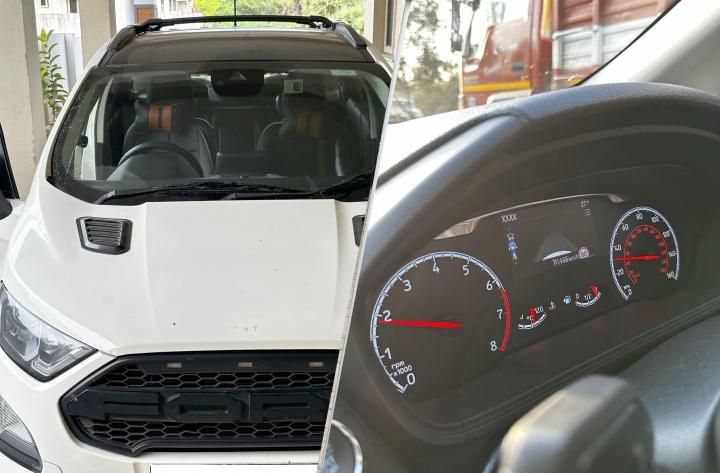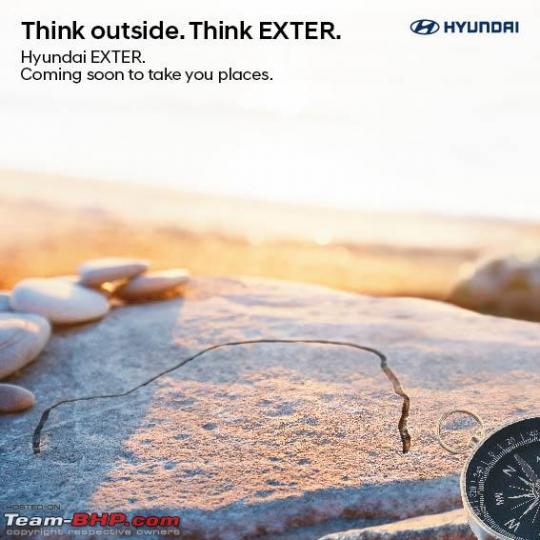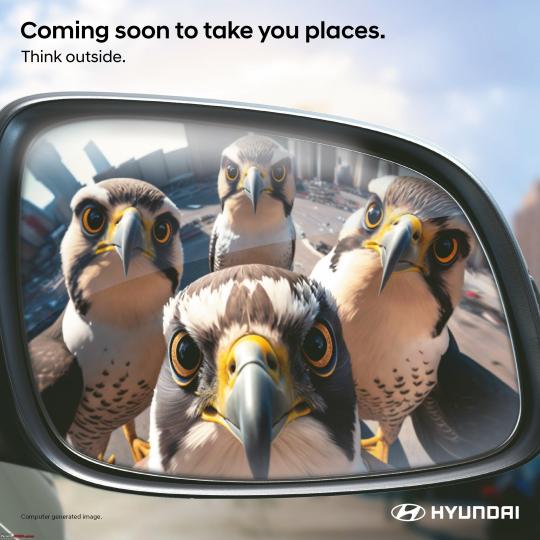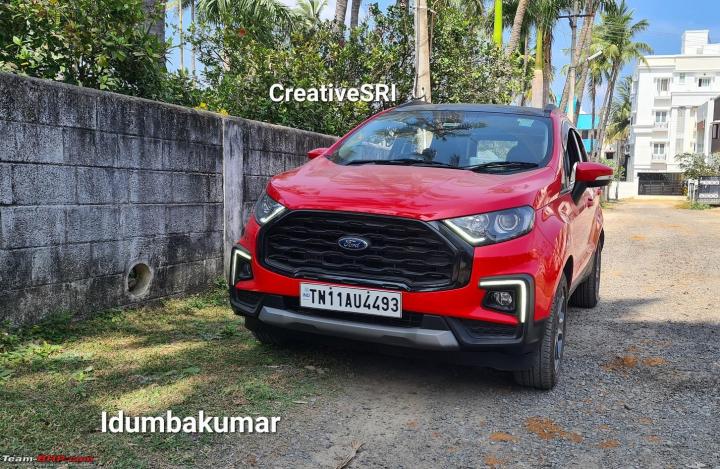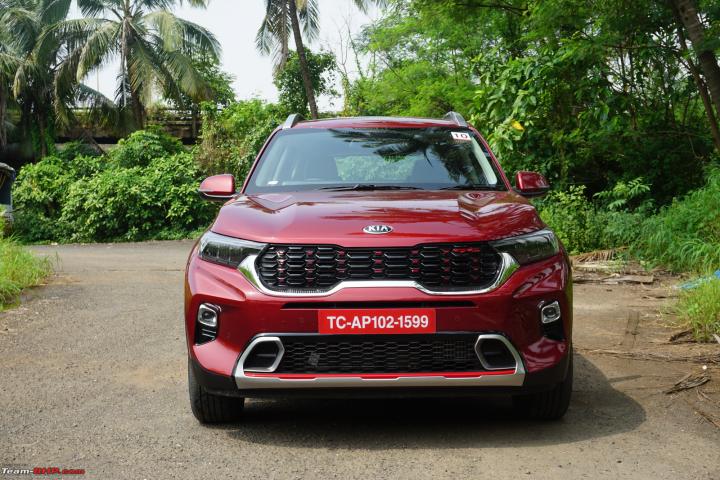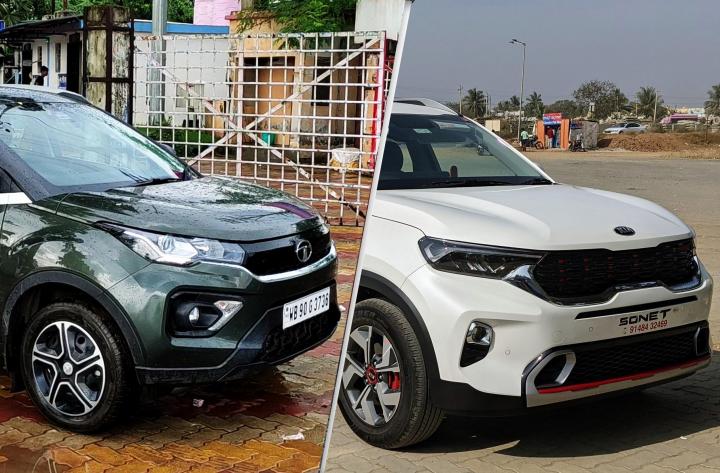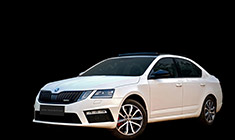News
DIY: How I retrofitted ADAS in my Ford Ecosport
Being a manual, stop and go function would not work in a car like mine. If the system detects that the engine is stalling or high-revving, it disengages and recommends the driver to perform a gear change.
BHPian nighthaven recently shared this with other enthusiasts.
Hello all. It's been sometime since I posted any updates. I have been away from the car for quite some time and had other priorities with whatever little time I could spend during my trips to India.
I finished installing Ford's Advanced driver-assistance system (ADAS) camera in the windshield and Adaptive Cruise Control Radar last week. Ford started offering EcoSport with Pre-Collision Assist (PCA) with Auto Emergency Braking (AEB) and Blind Spot Assist System (BLIS) with Cross-Traffic Alert (CTA) in Europe. I don't understand why Ford has not offered the same in USA variants, probably something to do with stringent road safety regulations in the EU. Other ADAS functions such as Lane Keeping System (LKS) and Adaptive Cruise Control (ACC) are not available in EcoSport anywhere in the world.
Major challenge with this mod is finding and installing an ADAS IPMA mounting bracket. For reference:
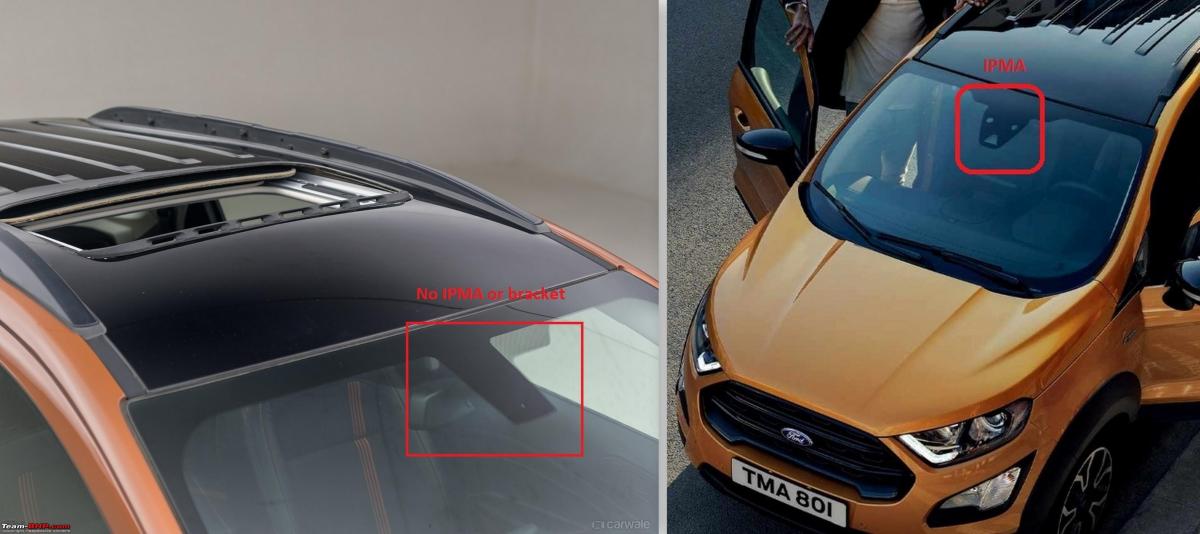
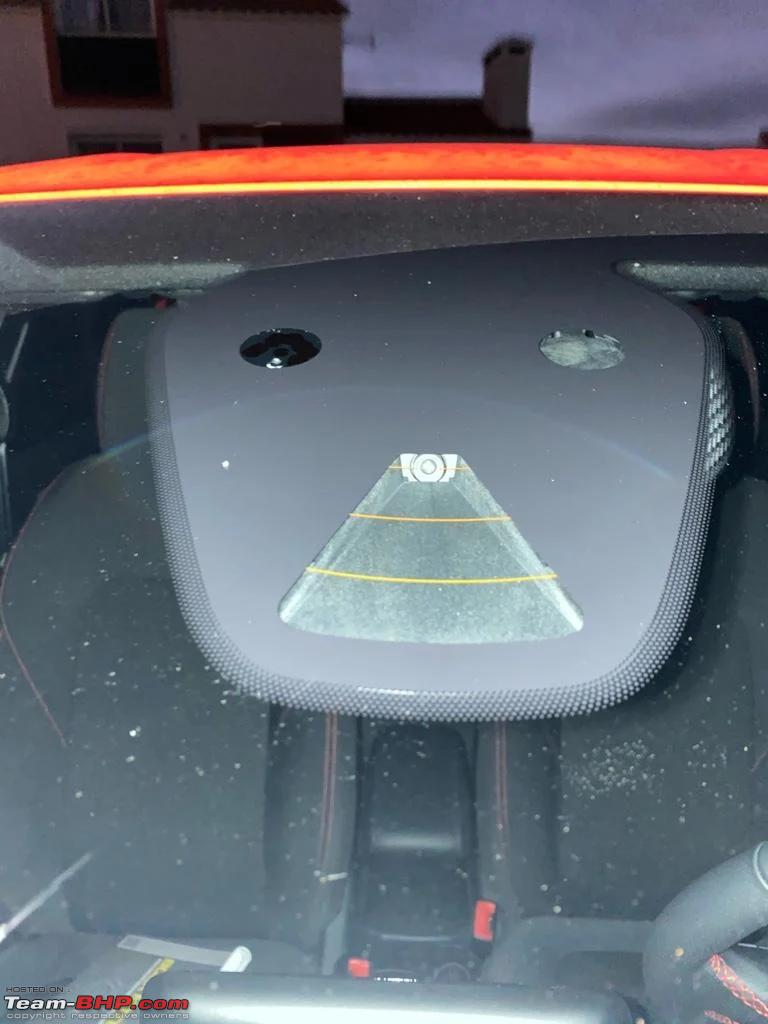
Close up.
Being a manual, stop and go function would not work in a car like mine. If the system detects that the engine is stalling or high-revving, it disengages and recommends the driver to perform a gear change. After gear change, the system resumes operation. This mod is still in progress. I have trouble calibrating the ACC radar as it requires ideal road conditions for calibration which I couldn't find near my hometown and I had very less time to tinker around. I will sort this out in my next visit.
Parts required:
- ADAS Camera from a Ford Focus mk4/Ford Fiesta mk8/EcoSport/Puma. Part no: ABCD-19H406-XY Price: 80 pounds.
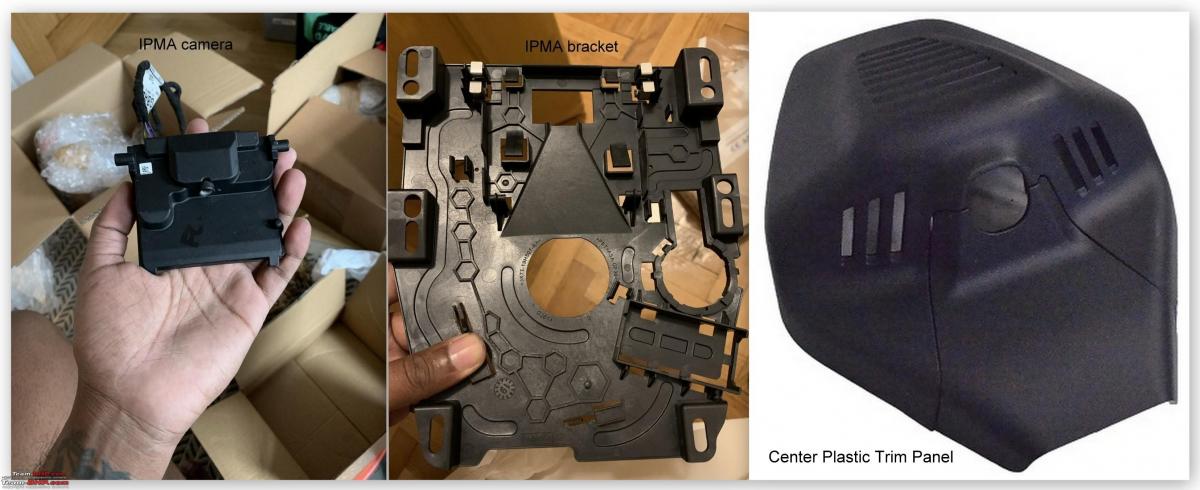
ABCD can vary depending on model year and donor car such as JX7T (focus mk4), H1BT (fiesta mk8), L1TT (Ecosport/puma). Any of the three should work as the hardware is the same model manufactured by Visteon.
'X' can be A/B/C (fiesta, puma, Ecosport) and G (for ford focus), defines the features available in the camera. A only supports Lane Departure Warning, B supports A features as well as TSR and AHB, C supports B features as well as ACC, PCA with AEB. Ideally it's best to go for the 'C' or 'G' variants as they support all features.
'Y' is the revision. So it doesn't matter.
- Windshield mounting bracket along with respective plastic trim panels (Price: 70 pounds) - This is not a child part and that makes it very challenging to find and buy. The mounting bracket comes attached with the windshield directly from the glass manufacturer. I had to search around and find a car recycler who pried open the bracket from a Ford focus windshield.
- ACC radar (Part no: ABCD-9G768-XY) (Price: 120 pounds).
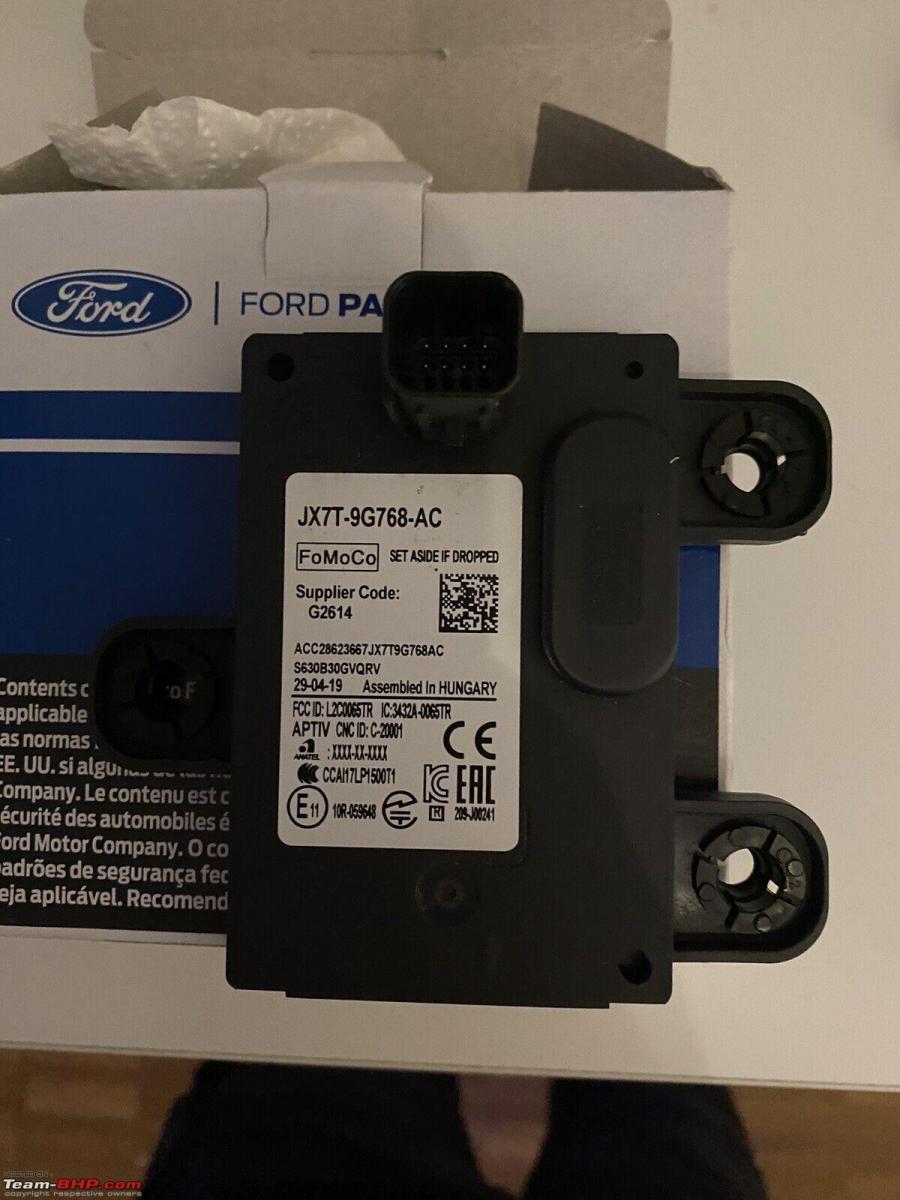
D code does not matter as long as the radar is from a Ford Focus mk4/Ford Fiesta mk8/Puma. This part is required only if you are looking to install Adaptive Cruise Control (ACC). At this point I dont know if I can make this function work or not.
Installation:
Removed the center mirror trim panel by pulling the two trims apart; unhooked the rain sensor and IRVM from the mounting button. There is silicone gel pad between the rain sensor and windshield glass to ensure there is no gap between them (to help with refraction). You will need this for the sensor to work effectively. Remove this very carefully as it can tear off easily.

Used a heat gun gently on the IRVM mounting button and Rain sensor bracket to weaken the adhesive and pried them out carefully from the glass. Store the IRVM mounting button and silicone gel pad as we will need them later. Rain sensor bracket is not required as the new ADAS mount has one.
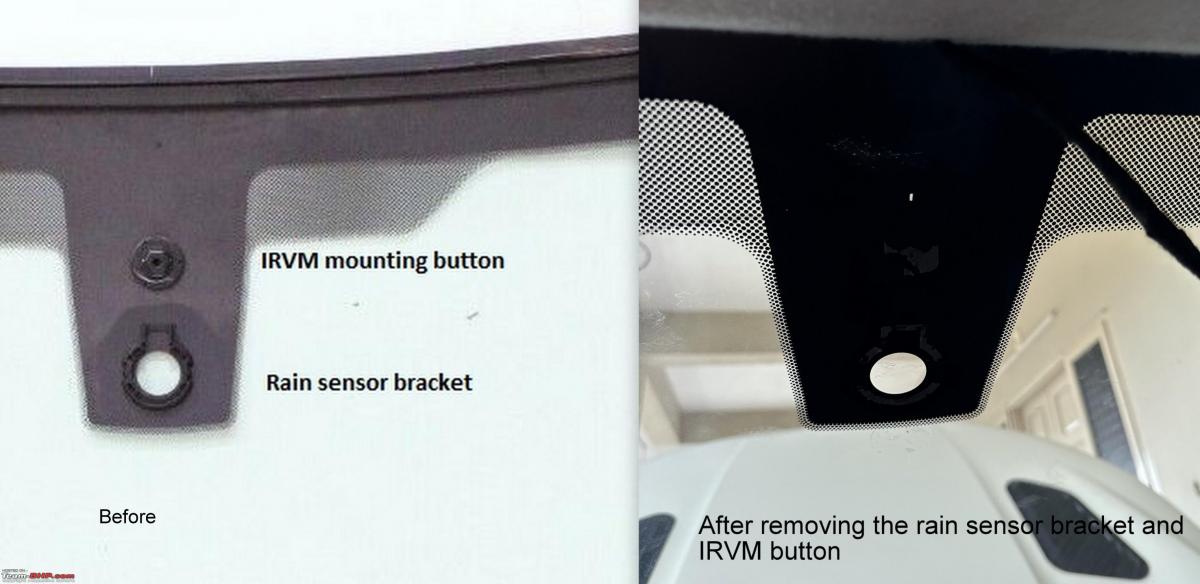
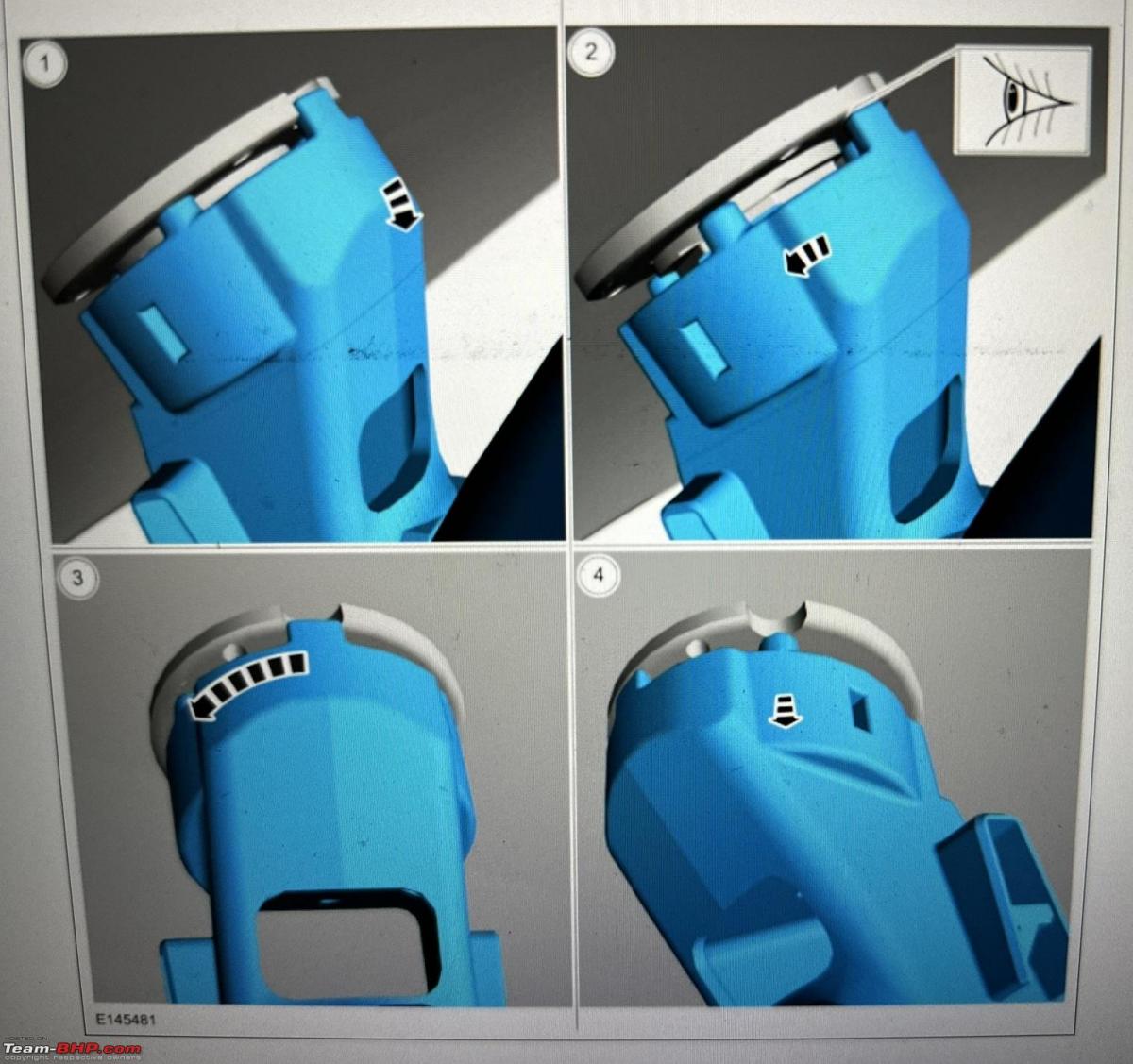
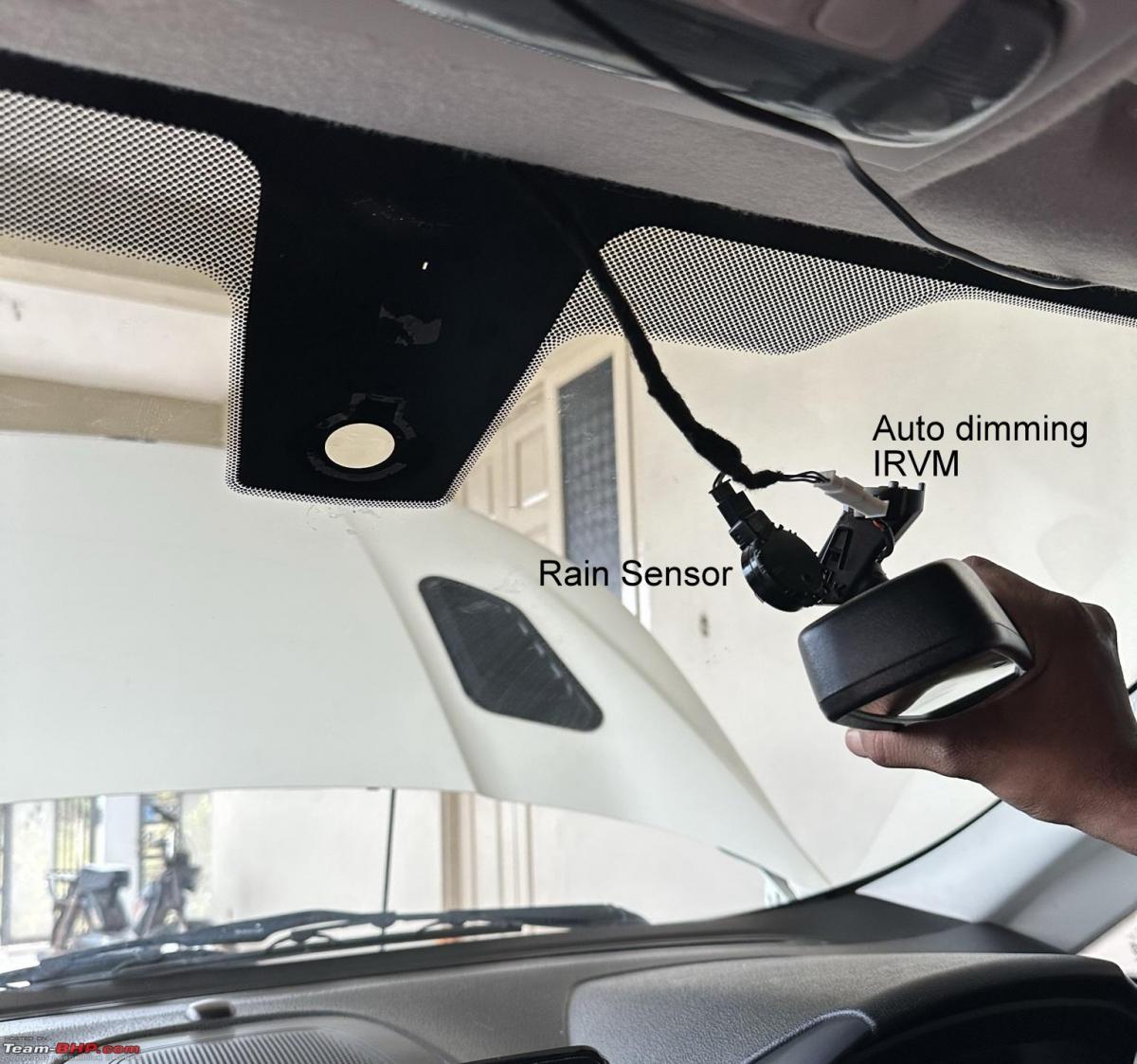
Aligned the mounting bracket on the windshield and marked the sensor locations that need to be sanded. Sanded the black layer (technically called 'Frit' and is baked on the top layer of the glass during manufacturing) with sand paper (Grit size: #80 - #120). Me and my brother did it manually taking turns as I did not have low grit paper which could be attached to a sanding machine. Sanded the surfaces progressively using a sanding machine (used a Black and Decker drill with a sanding attachment) with higher grit papers #240, #500, #1000, #2000, followed by polishing with ceriux oxide compound on a felt polishing pad. Spent about 15-20 minutes at each stage. This has to be most physically stressful mod I have ever done due to the ergonomically awkward posture involved. Ensure you are spraying enough water with breaks in between. DO NOT LET the glass OVERHEAT as it will melt the plastic layer laminated between the glass and will give a blurred look or worse crack the glass due to heat.
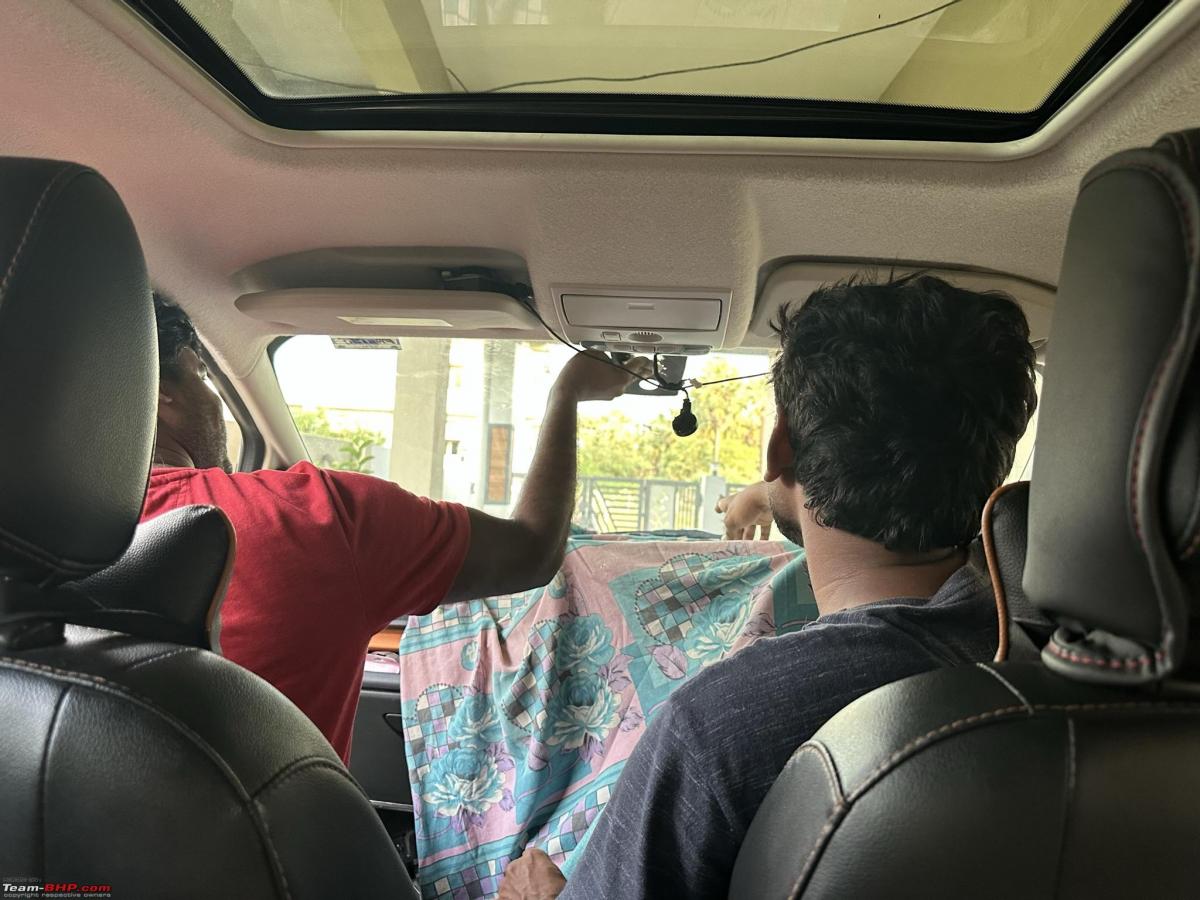
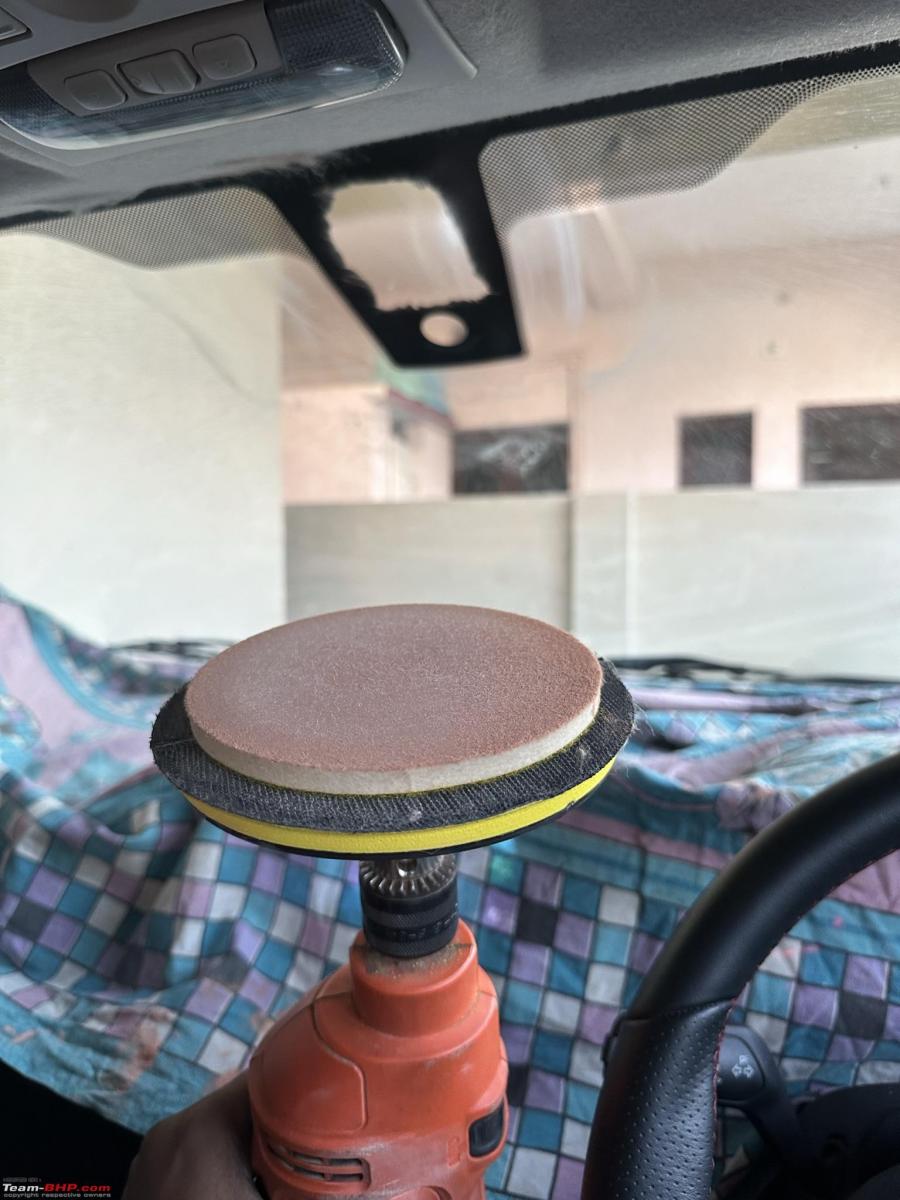
Sanding paper (I got from local market)
Cerium oxide powder (must be made into a paste with water)
Marked the mounting location on the glass using chart paper and paper tape cut in shape. This is to ensure that you are not applying primer on the surface you just sanded. Alignment of the bracket is very critical, therefore I had to recheck a 100 times before I moved forward. Once the sensor locations (sanded to 100% transparency) are covered in tape, I applied Sika Primer 207 (got from Ebay UK) on the marked areas. This primer is specially made for automotive glass to improve adhesion and provide UV protection. Allowed the primer to dry overnight.
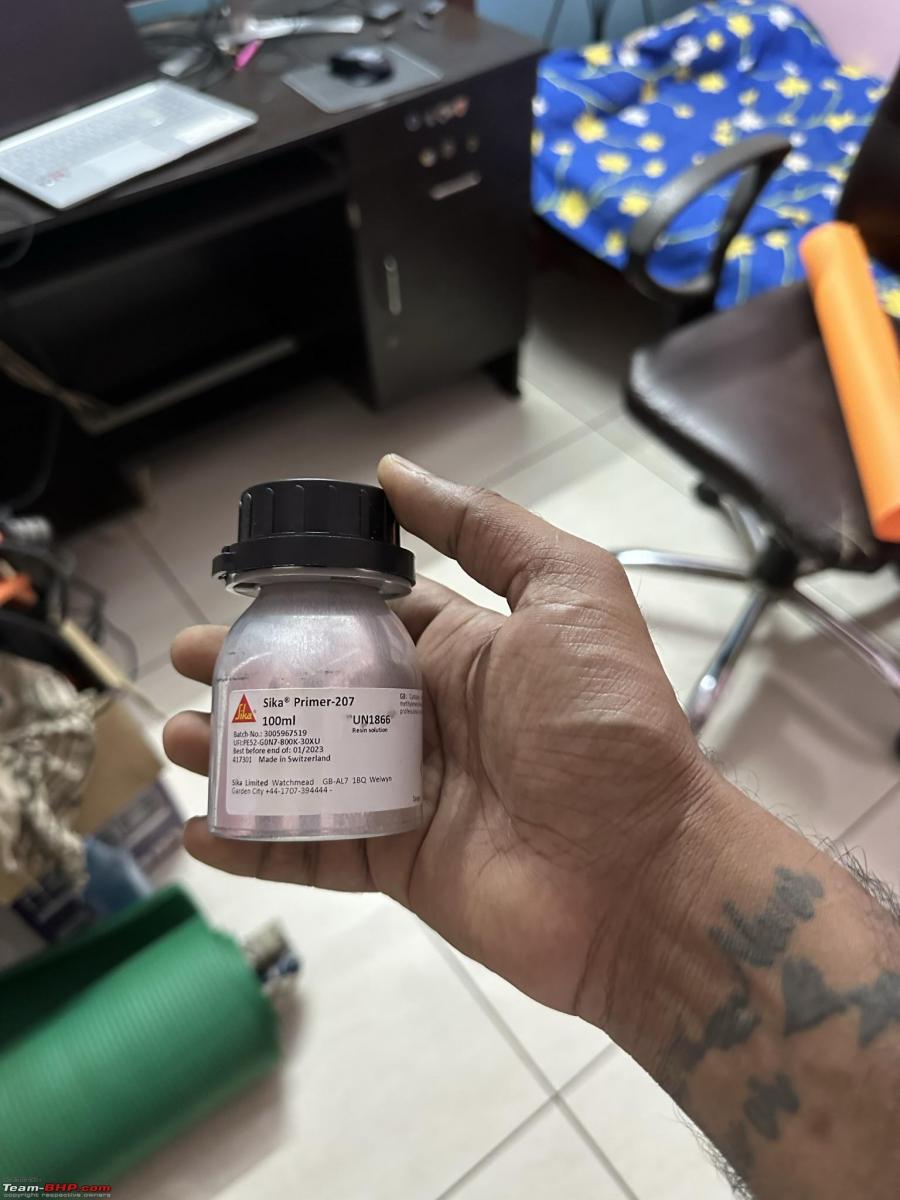
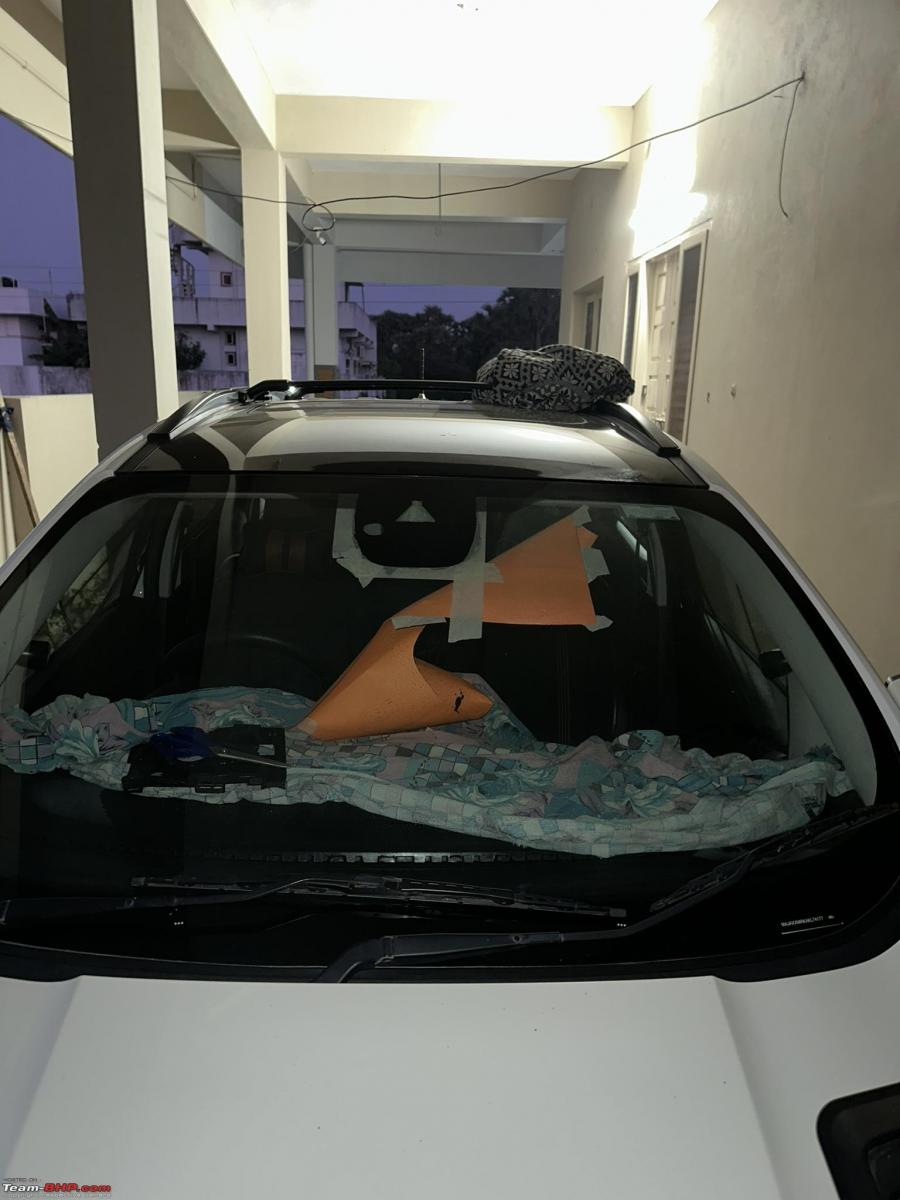
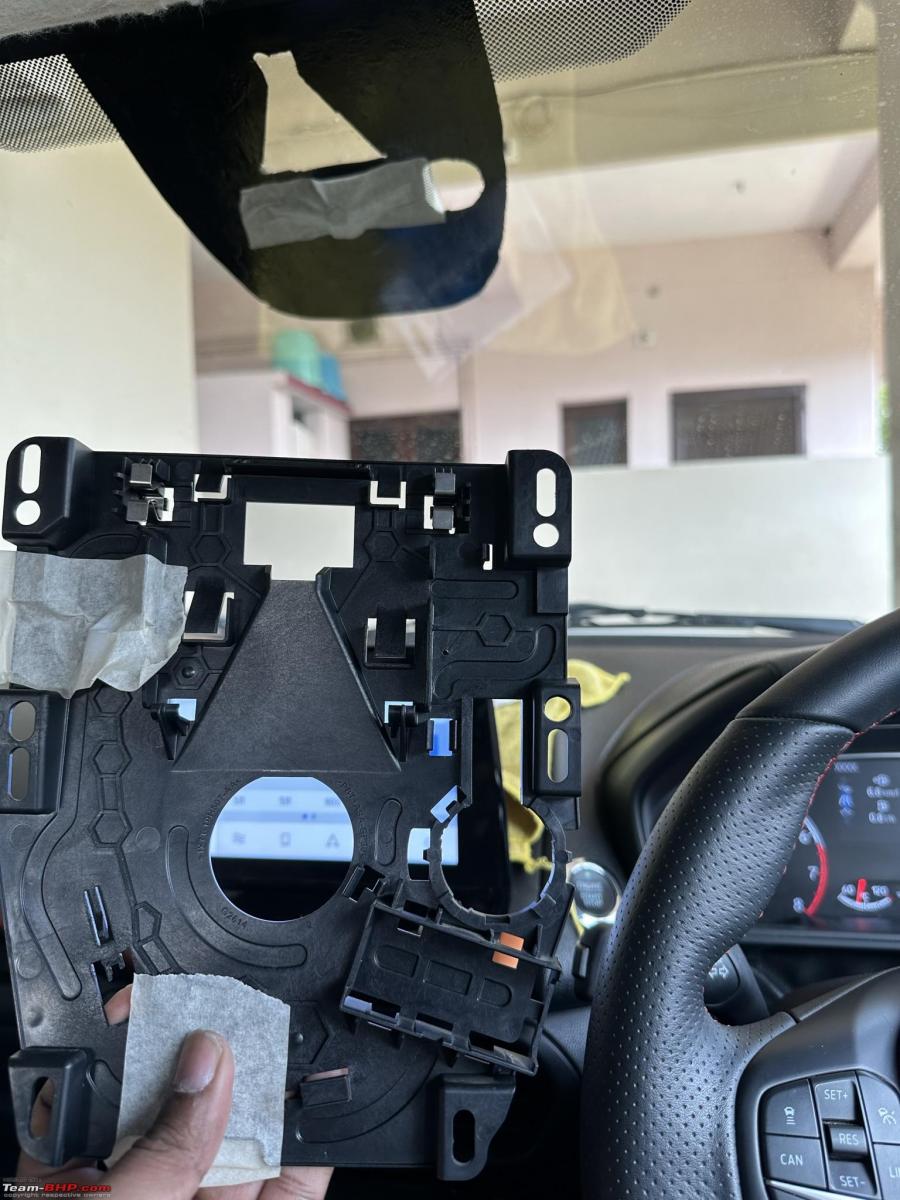
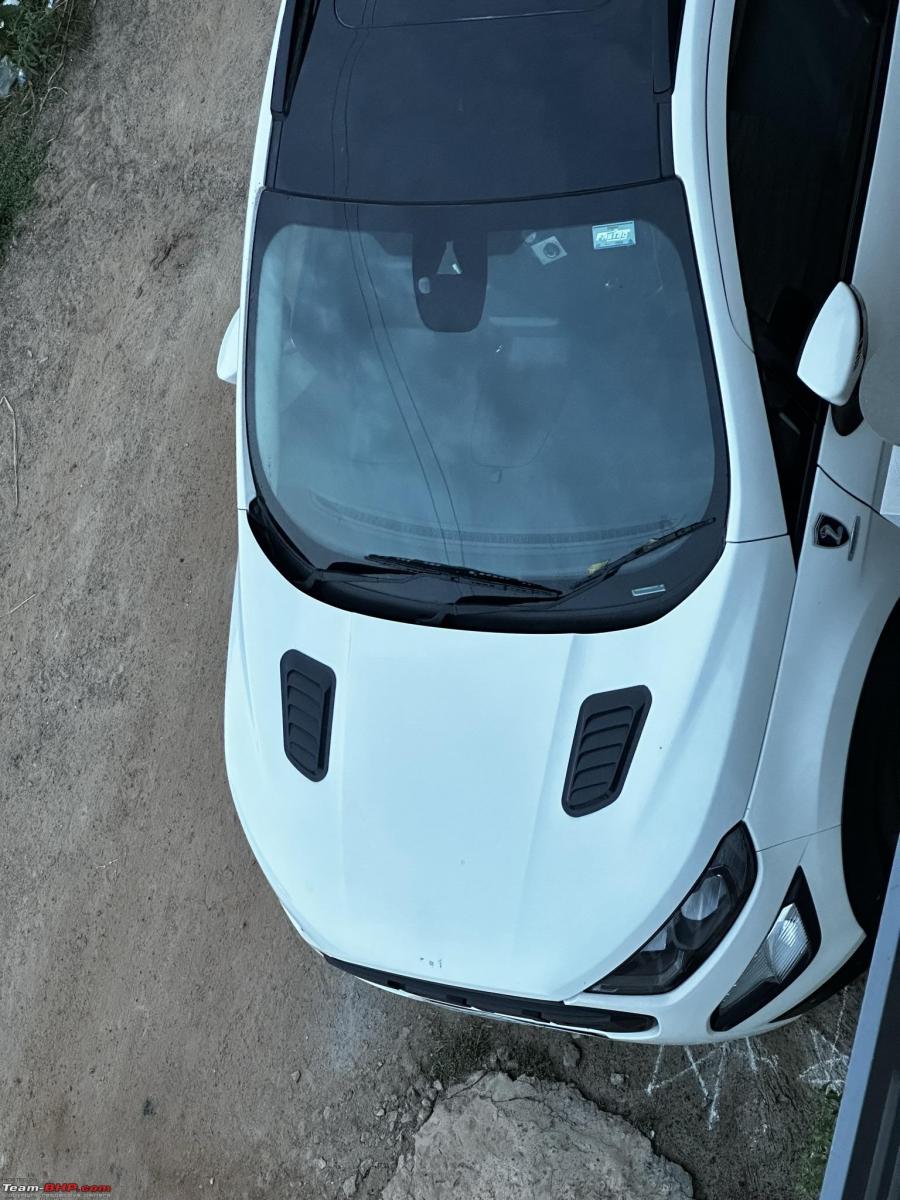
Used heat gun to warm up the mounting bracket and make it perfectly flat by applying pressure over a flat floor (my bracket had a small 5 degree curvature between top and bottom half which was inducing little play while trying to attach it to glass). Removed the tape carefully and then drove to a windshield glass installer. I had him apply Urethane adhesive (used for attaching new glass to the car body) on the mounting bracket along the marked locations for Rs.100 and stuck the bracket carefully on the windshield aligning the sanded sensor areas. Applied tape to hold the bracket in place until the adhesion process is complete for 1 hour.
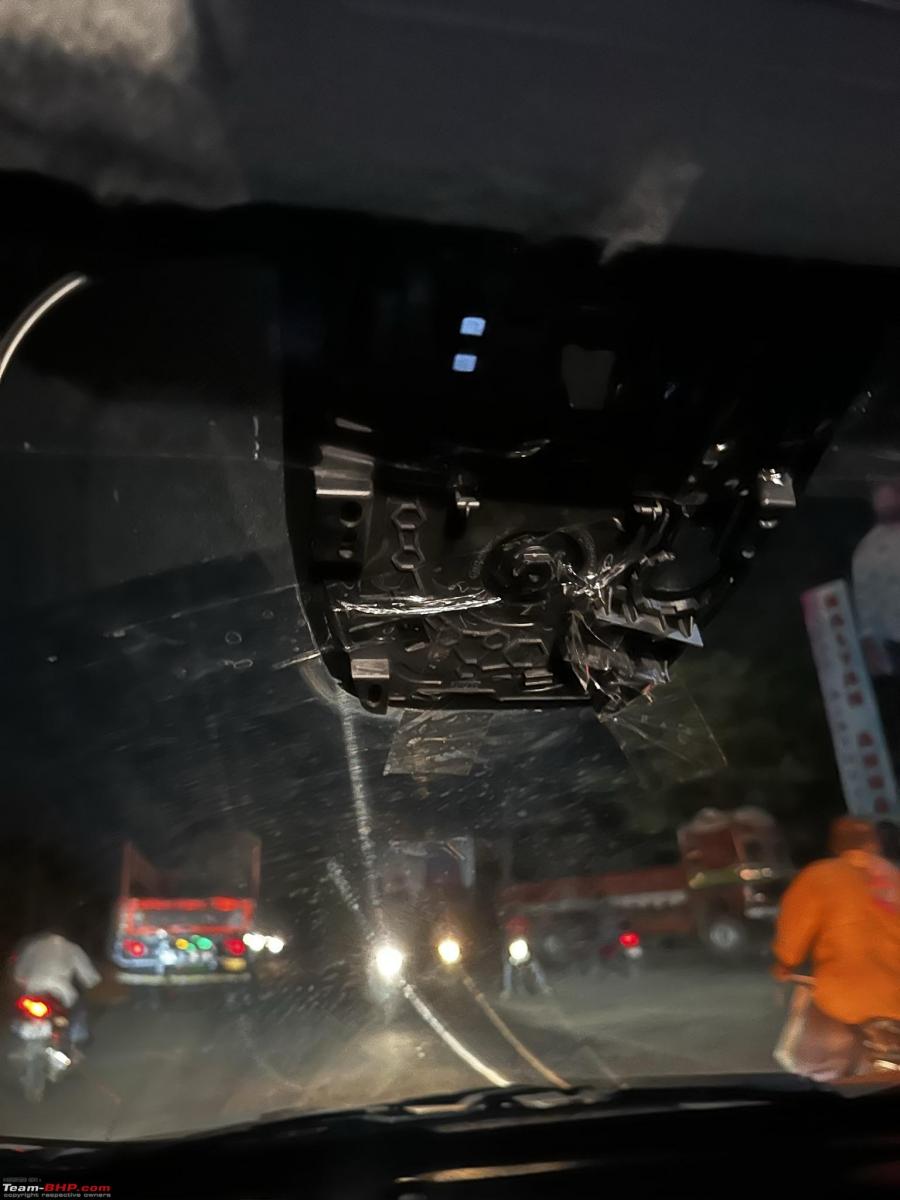
Sanded the IRVM mounting button until it was clean, applied permatex rear view mirror adhesive (got from Ebay UK) on the button as per instructions and fixed it on the glass at the center aligning with the ADAS mounting bracket. Applied tape on top of it to ensure sufficient tension while the adhesion is in progress for about 2 hours.
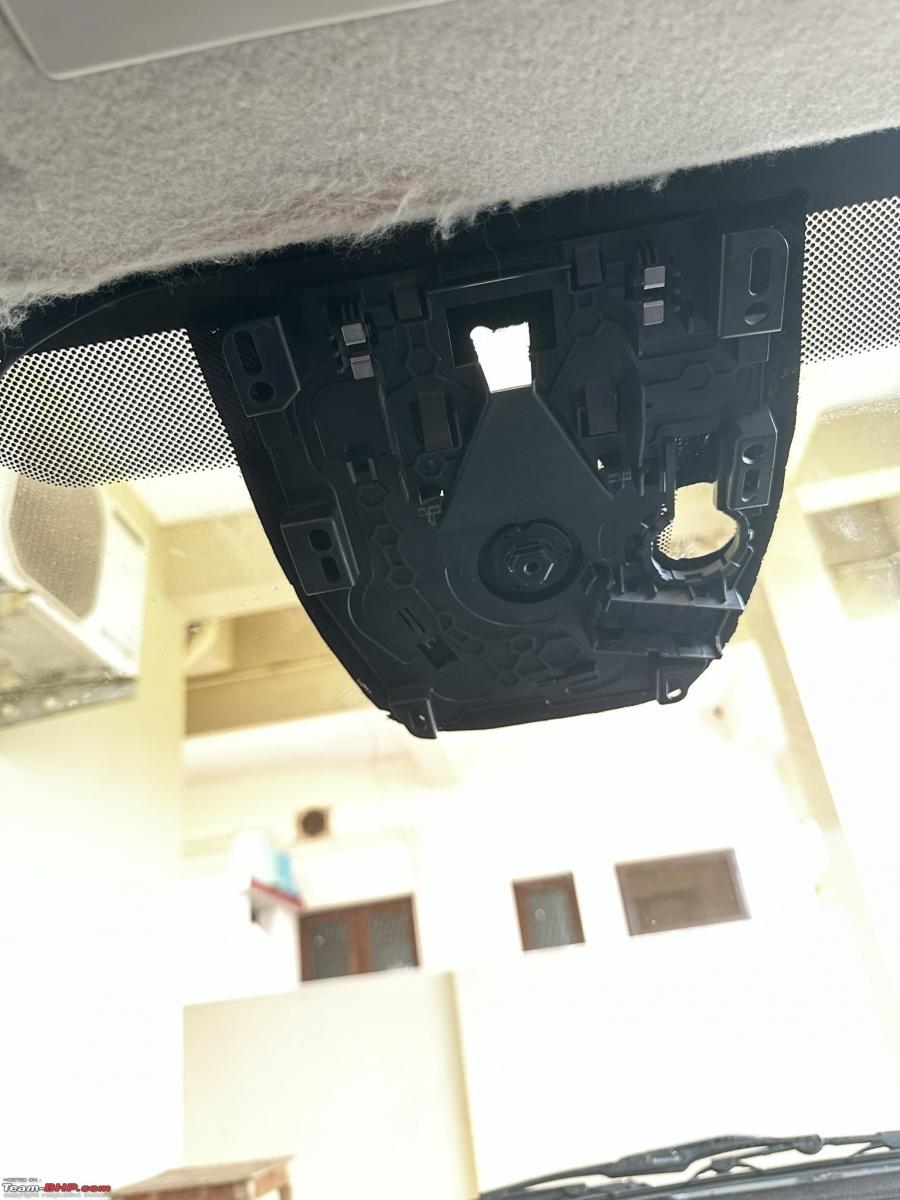
Mounted the IPMA camera and rain sensor (with silicone pad) on the new bracket. Used a six core cable to connect the IPMA camera to HS2 CAN bus (at OBD module), Power (have a fuse tap in passenger fuse box to power all my after market accessories and mods), and Radar (custom mounted last year during front parking sensor mod, refer to first post). Placed the new plastic trim panels to cover the retrofitted electronics.


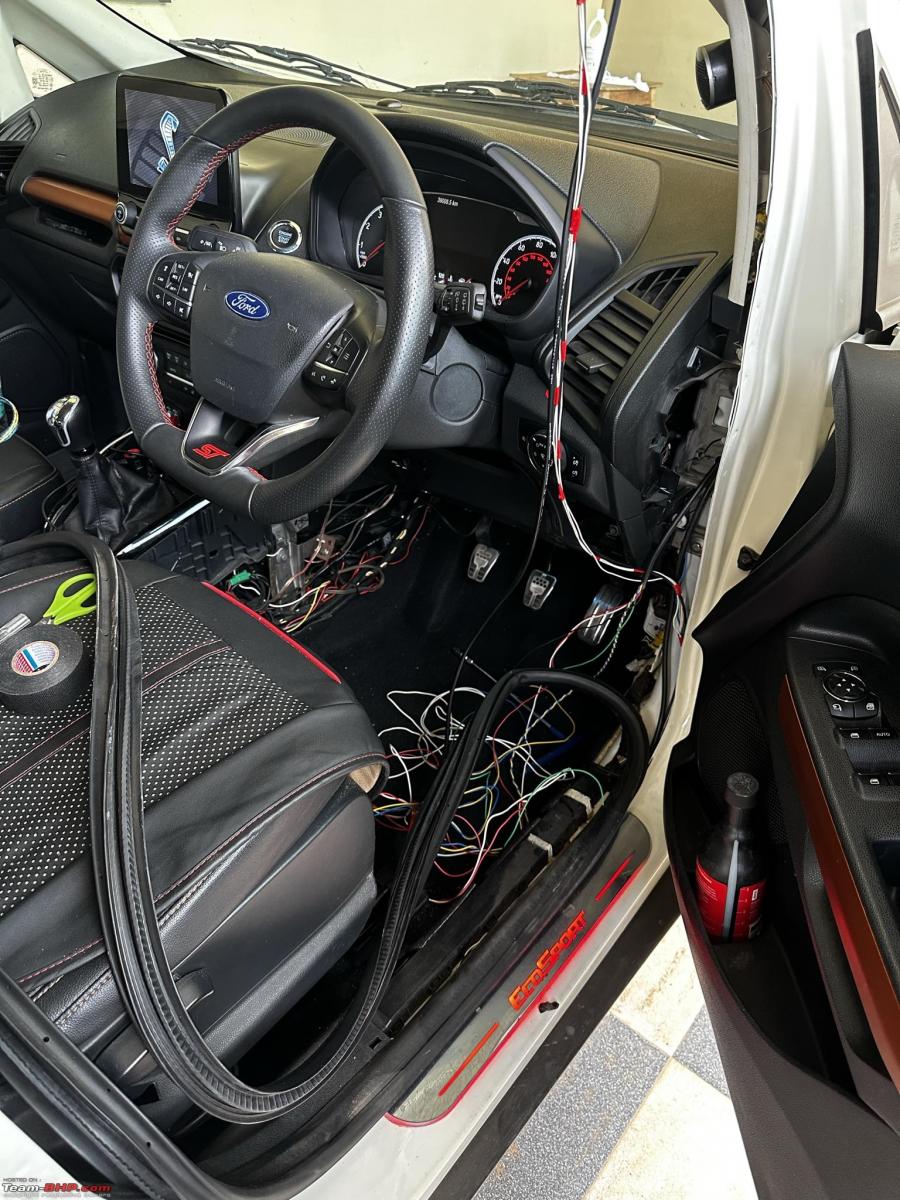
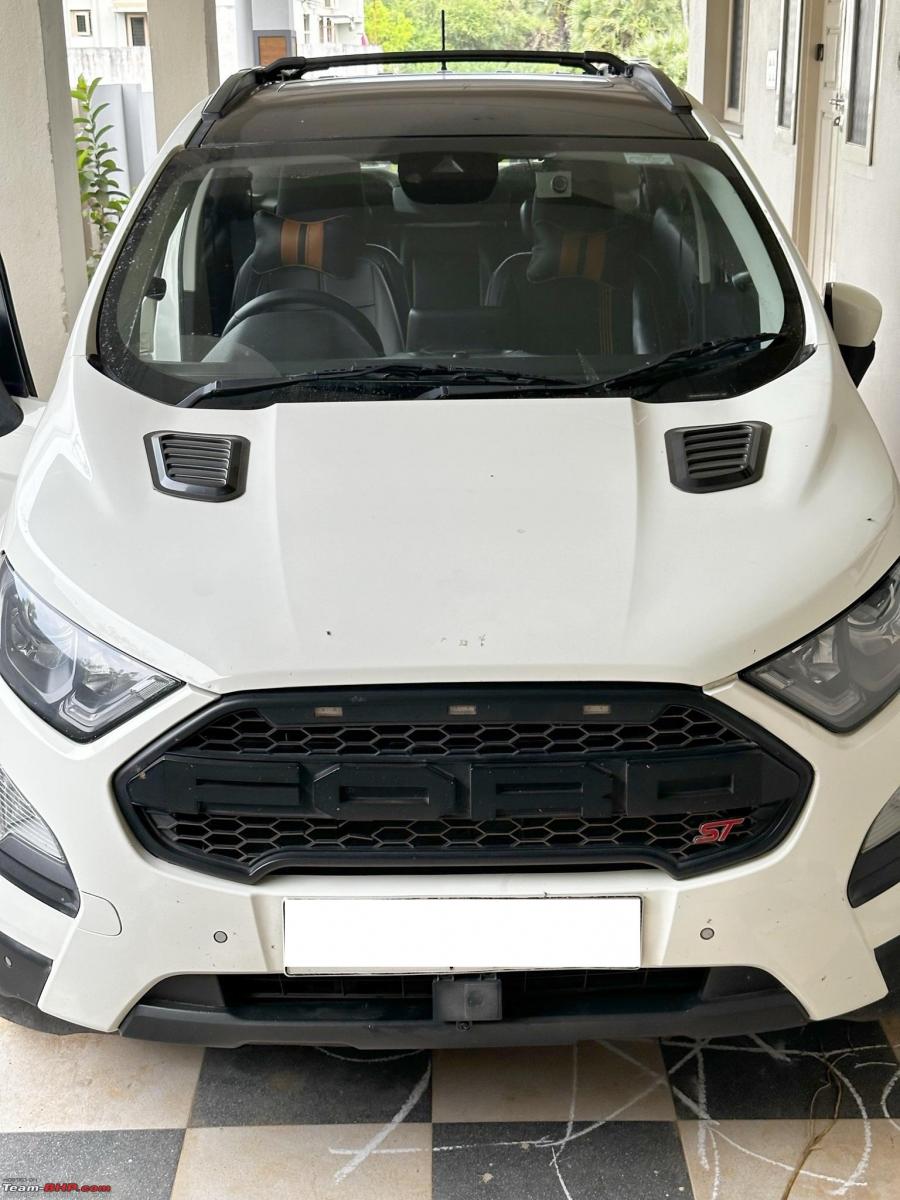
Jacked up the rear tyres and changed the unidirectional ABS sensors to bi-directional sensors on both rear wheels
Ecosport models with ADAS from 2020 come with an ABS controller that starts with LN15-2B373-XX (while indian varaints get an older firmware GN15-XXXX-XX) and new firmware which supports the ADAS functions and bi-directional sensors. Ford uses same controller (manufactured by ATE) on all their passenger cars. I tried flashing this new firmware onto mine using UCDS software previously, but for some reason it was unable to flash. I bought a used LN15 series ABS pump module (120 pounds) from Ebay UK and intended to install it into mine. As I have given up hope, I was tweaking and trying different flash settings in UCDS and voila! I was able to flash the new firmware onto my ABS module.

Fired up UCDS/Forscan and made the relevant changes in the ABS, IPC, IPMA, PCM, SCCM modules to enable the ADAS features. UCDS was throwing calibration missing error for the ADAS IPMA camera. For this the car needs to be driven for 10 minutes at 40 MPH (64 kmph) on a road with clear lane markings to calibrate the camera and alignment. The saddest part was I had no such road long enough near my home. I decided to calibrate the camera on the well built NH-5 as I was gonna fly off back to Frankfurt the next day from Visakhapatnam.




LKS:
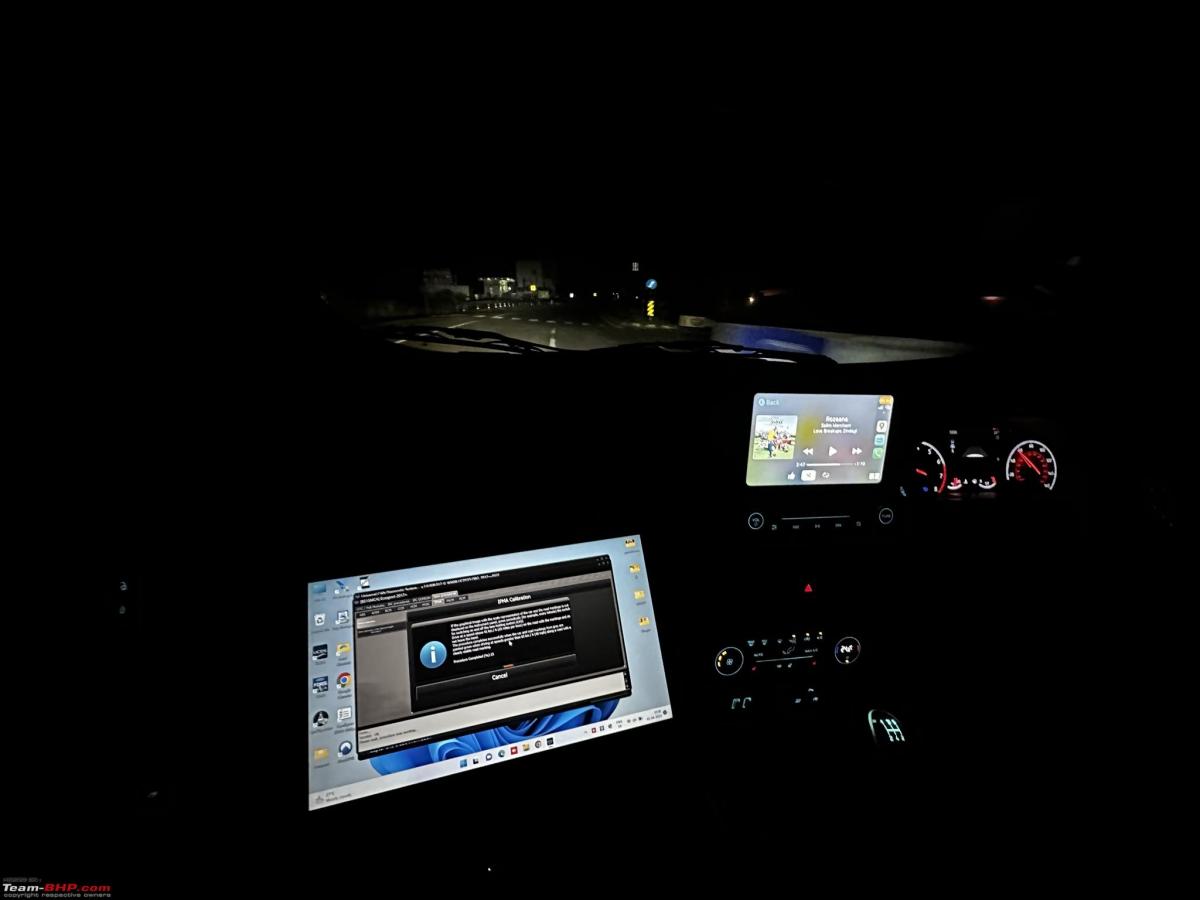
TSR:

Videos:
- ADAS functions on cluster.
- IPMA camera calibration.
- ADAS controls from the center stack. Some settings are glitchy as they are greyed out while they work on the settings in the instrument cluster.
Considering ADAS has inherent risks involved especially considering its a retrofit, I have currently activated only passive assist features. Active assist will be activated on public roads only after more testing such as AEB using dummy cardboard in controlled conditions when I am back. Considering I got the ADAS features to work on my way to airport leaving the country, I do not have any more videos to share. I look forward to getting back as soon as possible and continue my journey with ACC activation and PSCM retrofit.
Thank you for reading! Happy motoring and effortless mile munching!
Check out BHPian comments for more insights and information.
- Tags:
- Indian
- Ford Ecosport
- DIY
- ADAS
- Compact SUV
News
Booked a Tata Nexon AMT: Should I buy it or wait for the updated model
My wife won’t let go of the sunroof and I wont miss out on automatic transmission.
BHPian Vka257 recently shared this with other enthusiasts.
Dear esteemed members:
I am in a heavy dilemma and would love to hear all of your opinions to make an informed decision. I have just booked a Tata Nexon Petrol Automatic XMAS variant. We all know that Tata is gearing up for “something” in the Nexon timeline for the coming months. Here is the quagmire:
- I am eking out every last rupee I can of my budget to arrive at the perfect compromise of available and missing features.
- My wife won’t let go of the sunroof and I wont miss out on automatic transmission. This eliminates maximum cars except the XMAS variant Nexon at 11lakhs OTR.
- I will be sacrificing other should-have features like cruise control, rear defogger and front armrest.
- It is a tried and tested product by Tata which has eliminated most of the niggles.
Now Tata has been testing and teasing a new “iteration” of the Nexon which will come out anytime by next 4 months. The sales executives have no knowledge of this and no dealer training have been done for them. Here is the current picture:
- We do not know at this point if this is a next gen Nexon or merely a facelift.
- If it is a facelift, why the full camouflage and not just a covering up of front and rear bumper?
- Will this make a current Nexon totally obsolete? Will this come with a new quantum engine with a zillion horsepower? And given the Tata track record, will this quantum engine be full of nightmares or will be bulletproof from day 1?
- What if Tata decides to copy an XUV 700 and add 50” Tv screen dash from the base model?How much reliable will that be?
- Most importantly, what if Tata decides to yank this peculiar variant XMAS from line up where they donot provide a reverse camera but do come with sunroof? Where will I go with my paltry 11 lakh budget?
- On the other hand, if I take delivery of the current Nexon, will I look like an Idiot who buys a new car and it becomes old in less than a month?
TL DR version guys, what should I do? Wait for the new Nexon or grab the one which is allotted to me in next month or so? The automatic also has a waiting period of atleast 3 months but the dealer has promised delivery by mid - May. Its a Tata dealer. I don't trust him.
Thanks.
Here's what BHPian bjims had to say on the matter:
Coming to your query, Do you need an SUV in the first place? Would a hatchback or sedan suffice? Next, is the sunroof an absolute necessity?
If an SUV is not a necessity, I would suggest you look at other options from the hatchback segment like the i20, Baleno, Altroz, etc, or even a sedan like the Amaze. If an SUV is what your heart wants and if you are able to compromise on the sunroof, the Nissan Magnite CVT or the upcoming Maruti Fronx (which is a crossover) can be considered.
Else, if you can't compromise on both SUV and sunroof, the Nexon XMA(S) is your only option, and you could go for it. The only caveat is the upcoming Next-gen/facelift Nexon which should most probably be powered by the new 1.2-liter engine producing 125 bhp of power and 225 nm of torque which would be mostly mated to a new automatic transmission as well (most probably a DCA), hence prices are bound to rise, so in all possibility either you go for the current gen Nexon and get your car for 11 lakhs or you wait and get the New Nexon which would definitely cost more considering the updates.
Here's what BHPian DicKy had to say on the matter:
If you don't mind being in an outdated car, then go for the Nexon now as prices will only increase.
If you are going for the diesel manual, then wait for the new model since it looks like just a comprehensive facelfit than a generational change. The diesel won't have a big change mehcanically, but if you are going for the petrol (read new TGDI engine) or DCA (automatic), then wait for the nigles to be solved. Even then, prices will only go up.
Here's what BHPian Knightrider had to say on the matter:
Looks like you are on a fixed budget and Nexon XMAS is the best that you will get in that budget considering the must have feature (sunroof) and automatic.
I completely agree with your shortlisted car and variant. I believe Jazz was the only other car that was available in this budget and had a sunroof. So you at least don't have other options to look at.
Looking at the teasers that Tata is posting for last 2 days on their social media pages, the facelift might be launched sooner than we anticipated. So there are high chances you will come to know about the facelift before the delivery of your Nexon. But do note that the facelift will be more expensive than the current one.
Here's what BHPian Archisman had to say on the matter:
I am in the same boat. This entire long weekend took test drives of XUV 300 W8 (O) manual, Kiger Manual and Kiger CVT, Nexon XZ+(S) manual and AMT. By far Nexon manual was most comfortable in terms of driving and performance.
I am given to believe from posts here in the forum that facelift is expected by late 2023 or early 2024 and hence trying to buy now. However if it is coming in next two to three months, then I will wait. The problem is the Sales Advisor here in Baroda is not sure when it will come and what is the expected price range (I understand this as no one except the TATA big bosses know). This suspense is actually killing me.
Check out BHPian comments for more insights and information.
- Tags:
- Indian
- Tata
- Tata Nexon
- AMT
- Compact SUV
News
Hyundai's Tata Punch rival to be called Exter
The Hyundai Exter (codenamed: Ai3) is said to be based on the same platform as the Grand i10 NIOS and Aura.
Hyundai's upcoming sub-compact SUV has been christened 'Exter'. The new model will compete with the likes of the Tata Punch and is likely to be unveiled in the near future, with an official launch expected sometime during the festive season.
The Hyundai Exter (codenamed: Ai3) is said to be based on the same platform as the Grand i10 NIOS and Aura. It is the 8th model in Hyundai's line-up with an SUV body style. It will be positioned below the Venue in Hyundai's line-up.
Spy images suggest that the Exter will feature a tall boy design with a large greenhouse and an upright stance. It is likely to get roof rails, a sunroof and a shark fin antenna.
The Exter is expected to be offered with the same 1.2-litre petrol engine as the Venue, Grand i10 NIOS and Aura. However, it is unlikely to get a diesel engine option.
- Tags:
- Indian
- Compact SUV
- Tata Punch
- Exter
News
Hyundai Ai3 compact SUV teased; to rival Tata Punch
The car will be positioned below the Venue in Hyundai's line-up and will compete with the Tata Punch.
Hyundai has released official teasers of its upcoming compact SUV. The new model (codenamed: Ai3) is expected to be launched around August this year.
The Hyundai Ai3 is said to be based on the same platform as the Grand i10 NIOS and Aura. The car will be positioned below the Venue in Hyundai's line-up and will compete with the Tata Punch.
The Ai3's exterior design is likely to be inspired by the Casper that is currently on sale in the global market. That being said, the Ai3 will be slightly larger in size. Spy images suggest that the crossover will have a more upright stance with a large greenhouse. It is expected to get a sunroof as well.
The Hyundai Ai3 could be powered by the same 1.2-litre petrol engine that is available in the Venue, Grand i10 NIOS and Aura. It is unlikely to get a diesel engine option.
- Tags:
- Indian
- Tata Punch
- Compact SUV
- Teaser
News
Living with my Kia Sonet petrol IMT: 3 years of ownership & counting
Great road presence, especially high set headlamps and tiger nose grill. Lights work well and illuminate even in pitch darkness.
BHPian TheMbaCarGuy recently shared this with other enthusiasts.
Shortlisting and buying:
I come from a family of hardcore Maruti Suzuki fan club - Maruti 800 Dx (2001, 16v MPFI), WagonR Vxi (2004, “Canary Yellow '') and Swift Dzire Vxi (2013). My dad especially is super impressed by mileage (duh!), easy and low cost maintenance and reliability of MS cars. We wished to switch to a bigger looking car thus considering C segment sedans, compact SUV and mid-size SUVs, around a budget range of 15 lakhs. The SUVs quickly trumped the low seating of the sedans and compact SUVs were chosen looking at the budget. Long story short - Brezza, though a MS did not offer - features, comfort or power of its Korean cousins, Venue seemed cramped, Nexon’s shape felt to be a pumped up Bolt / Indica Vista. Between XUV 300 and Kia Sonet, Sonet was the choice with top class interiors, aggressive looks and better front seating.
Overview:
Our daily usage is about 20-30kms all city driving, usually consisting of short trips. Great AC, peppy engine, decent steering (not as light as Venue) and ventilated seats make it a great drive. Usually clocking a 10-12 Kmpl with AC on Auto and slightly aggressive driving. Twice a month outstation highway drives about 500 kms, high performance is superb with seamless acceleration till 130+ kmph, with great stability. The steering wheel weighs nicely and slightly firm suspension adds to limited roll / pitch.
Engine:
1 litre GDI is a strong mill, with enough grunt to pull the car over steep slopes and small footpaths easily. IMT works great with minimal interference and accurate nudges if needed. Gear slotting is smooth and accurate. There is palpable turbo lag below 1500 RPM, but keep the pot boiling above 1800 RPM, engine is bliss. Over 2 years there has been no engine related complaint apart from one instance of belt pulley squeaking (one nut tightened, all ok). I tried my best to drive economically - shift perfectly, AC at 24 C, reach 6th gear by 60 kmph, could not get more than 14 kmpl in the city. On highways this number with normal driving and occasional fun speed of 120+ (average around 100) , could get a 17-18 kmpl with AC, 3 healthy people onboard. Engine shows remarkable sensitivity to external temperatures, at cold temperatures about 15 C, on highways I could get 20 kmpl +.
There have been 2 transmission overheat warnings - both with valets on steep hotel parkings, but never repeated. Returned to normal working in 5 mins of parking in shade.
Drive and handling:
Though heavy, the steering doesn't feel punitive at all in the city. Cramped parking, small lanes, tight 3 point turns, all with ease. Turning is sharp with minimal roll. The suspension makes its stiffness felt while running empty on speed breakers, there is some amount of sharp jerk if your are not careful. Rear suspension seemed to have developed some rattle - was fixed in 10k service along with wheel arch lining. On the contrary, if >50 kmph on sharp dips (where concrete road merges with tar road) I have seen the front suspension bottoming out. Hill hold and hill climb both functions work well, even on gravel surfaces.
Braking:
Does the job well, nothing to complain about. For the first 6 months, when brakes were pressed, grinding vibrations were observed, I was worried about gear-box - clutch issues, but this was resolved with ABS recalibration.
Interiors:
Well put, superb quality. The all black cabin does become a furnace in 40 degree+ heat, but AC and ventilated seats fight the battle well. Front seat comfort is good, with great visibility. Steering wraps, leather upholstery is still in great shape with no cracks or hardening. Infotainment works pretty much seamlessly 90% of the times, with some glitched in Bluetooth connectivity and voice commands. Android auto and Carplay work fine too. Wireless charging pad seem to heat up a lot, I avoid it on super sunny days. Rear seat is best for 2 full size adults (My family has an Xl Tshirt folks). Third is workable but not in super comfort. Rear AC works well, but will require some front vents directed if the cabin is too hot. Auto dimming mirror is quick to react and works well.
Exteriors:
Great road presence, especially high set headlamps and tiger nose grill. Lights work well and illuminate even in pitch darkness. The fog lamps though are subpar, with negligible addition to illumination. We did not opt for much accessories apart from a few chrome embellishments around fog lamps and rear reflectors and window visors (recommended). Aftermarket accessories are about 40% cheaper than Kia parts.
After sales service:
Apart from the little issues that were resolved quickly, the upkeep (washing, shampooing, polishing) needed a lot of follow-up, especially post monsoon clean-ups, wheel wells were not really cleaned well.
Verdict:
Overall excellent experience with vehicle. While it's not VFM in the category, the extra money goes a long way.
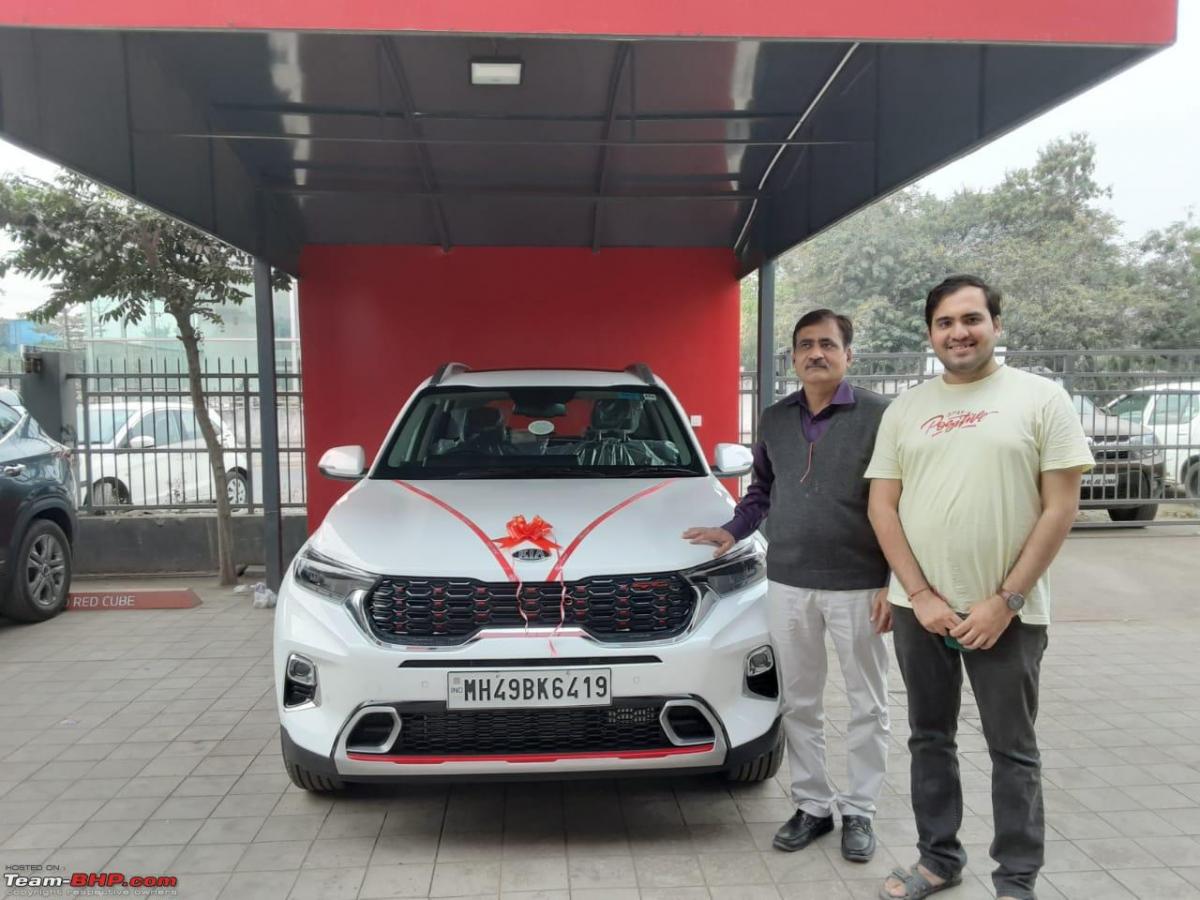
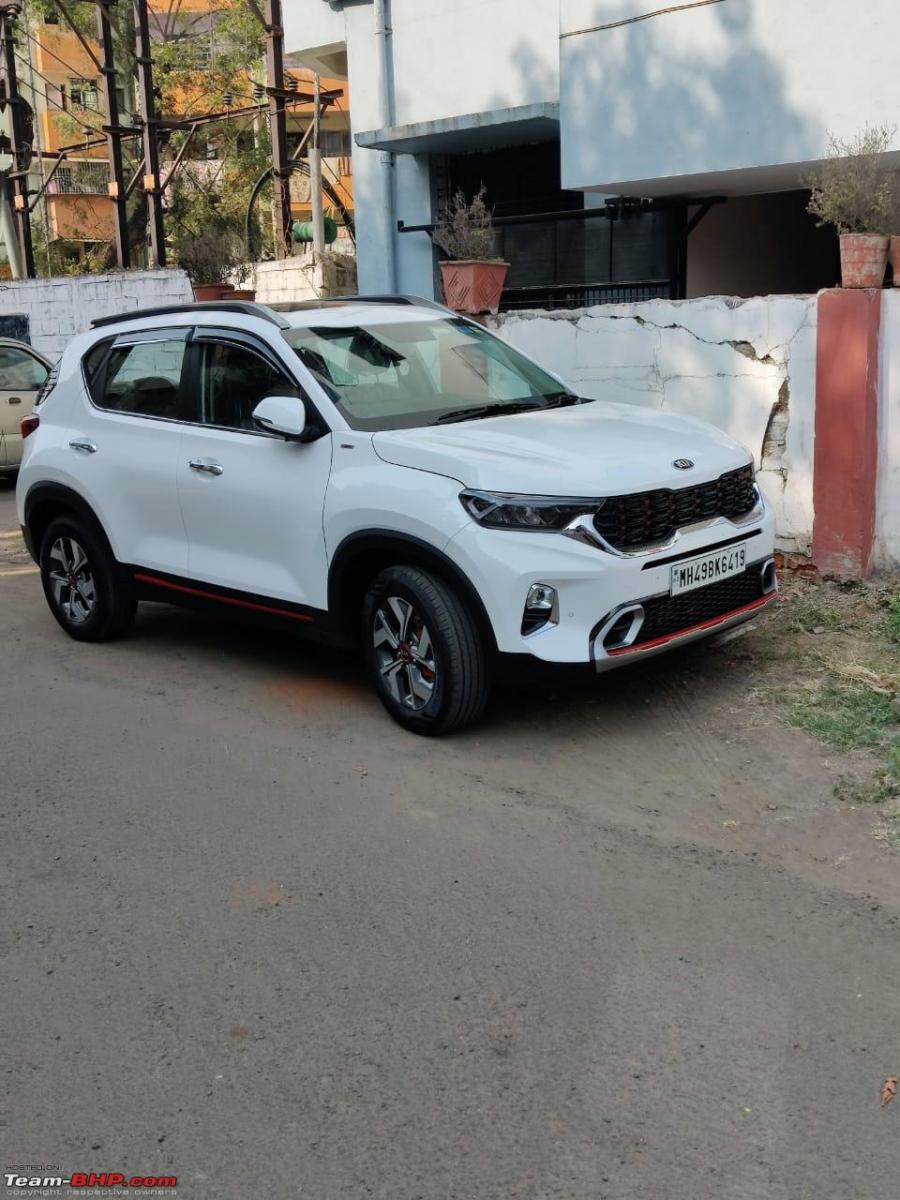
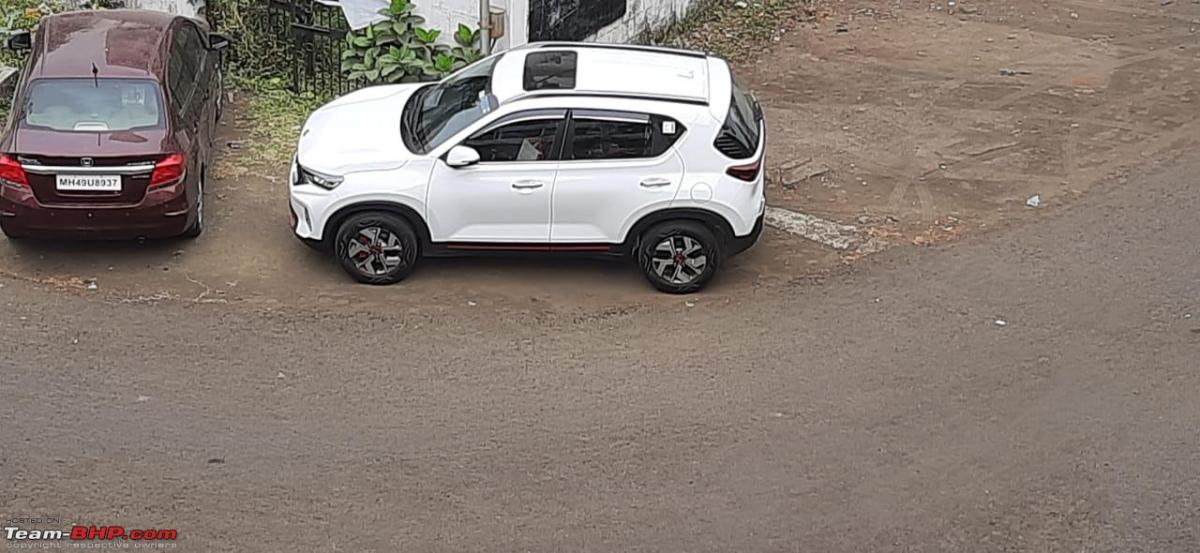
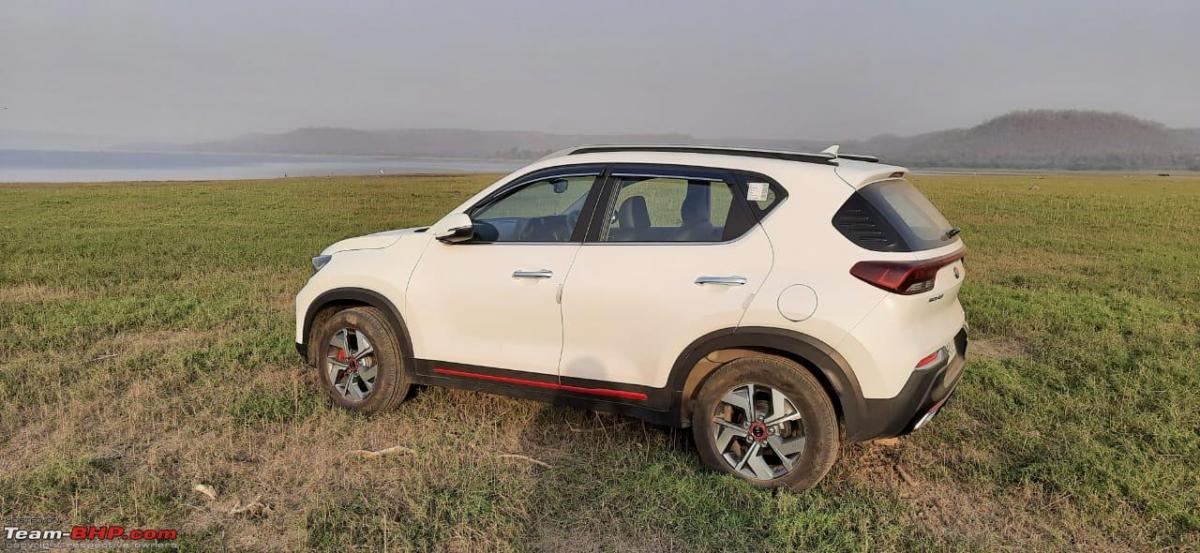
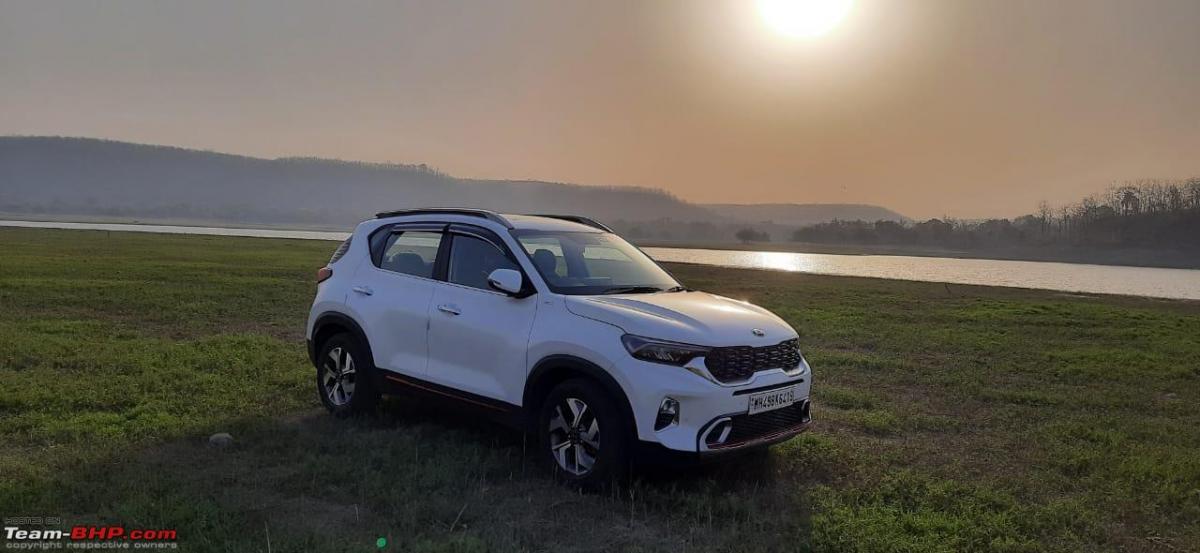
Check out BHPian comments for more insights and information.
News
Hyundai Ai3 spotted testing in India; to rival Tata Punch
The Ai3 CUV shares its platform with the Grand i10 NIOS and Aura, and will be positioned below the Venue
Hyundai is working on a new sub-4 meter SUV to take on the Tata Punch. Dubbed the Hyundai Ai3, the new model has now been spotted testing in India.
The Ai3 CUV shares its platform with the Grand i10 NIOS and Aura. It will be positioned below the Venue in Hyundai’s line-up and is expected to be launched during the festive season.
The latest spy images reveal an early test mule of the upcoming car. It has an upright stance with a large greenhouse. This particular test car is equipped with steel wheels, roof rails and a shark fin antenna. The car is also likely to get a sunroof.
The Hyundai Ai3 is expected to be offered with the same 1.2-litre petrol engine as the Venue, Grand i10 NIOS and Aura. The carmaker is unlike to offer a diesel engine option, though.
Source: Autocar India
- Tags:
- Indian
- Compact SUV
- Casper
- Tata Punch
- Punch
News
Ford didn't launch the Ecosport facelift in India so I recreated it
As I used to get Ford genuine parts through some dealers, I got a chance to get the various parts from the unlaunched version of EcoSport.
BHPian jhenu recently shared this with other enthusiasts.
Hello everyone. I am coming back with another big modification, especially of interest to Ford owners. Some people might have booked this thinking that they would receive this model. But unfortunately, it didn't happen as Ford shut down its operations in India. They completely scrapped every single part.
Here, I am going to show in detail the unlaunched Ford EcoSport 2021, which is a completely production-ready design and its parts.
People already might have seen this model when it was tested on the roads or via spy shots or maybe in some vehicle yards. But later, Ford announced its exit. This model also had to be scrapped. Yes, all the parts from this car had been declared scrap and given to scrap dealers.
Official spyshots:
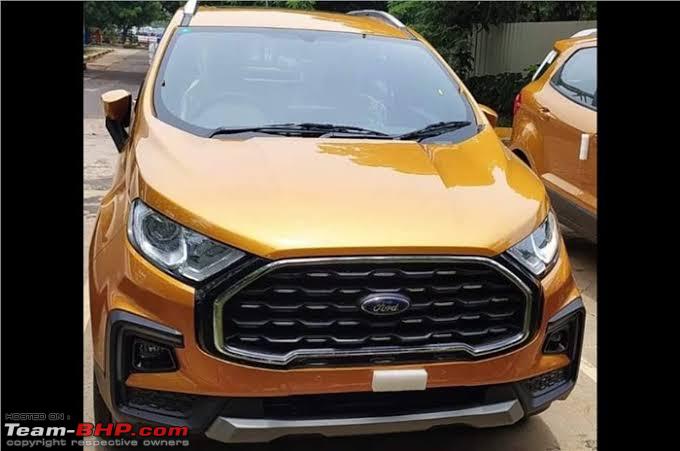
As I used to get Ford genuine parts through some dealers, I got a chance to get the various parts from the unlaunched version of EcoSport. So I decided to try to install them on the last available model as it's compatible with these parts.
Below is a list of parts required for the conversion:
- Front bumper full.
- Faux skid plate.
- Lower air deflector.
- Bumper holder.
- Air intake frame.
- Fog lamp frame.
- Radiator main grille.
- DRL indicator cluster.
- Fog lamp (round one).
- Tail light.
- Some screws.
The tail light, in particular, was a completely scrapped unit. But I somehow turned it into a working unit. I had to change the glass cover as well, but I made it look like a direct fit and a fully working unit.
I have procured all the necessary parts mentioned above and installed them on my own as basically, I'm a complete DIY person. I love to do R&D.
Assembled bumper before painting:

After painting:

I haven't taken pics during the installation. Here below, I am posting the post installation pics:
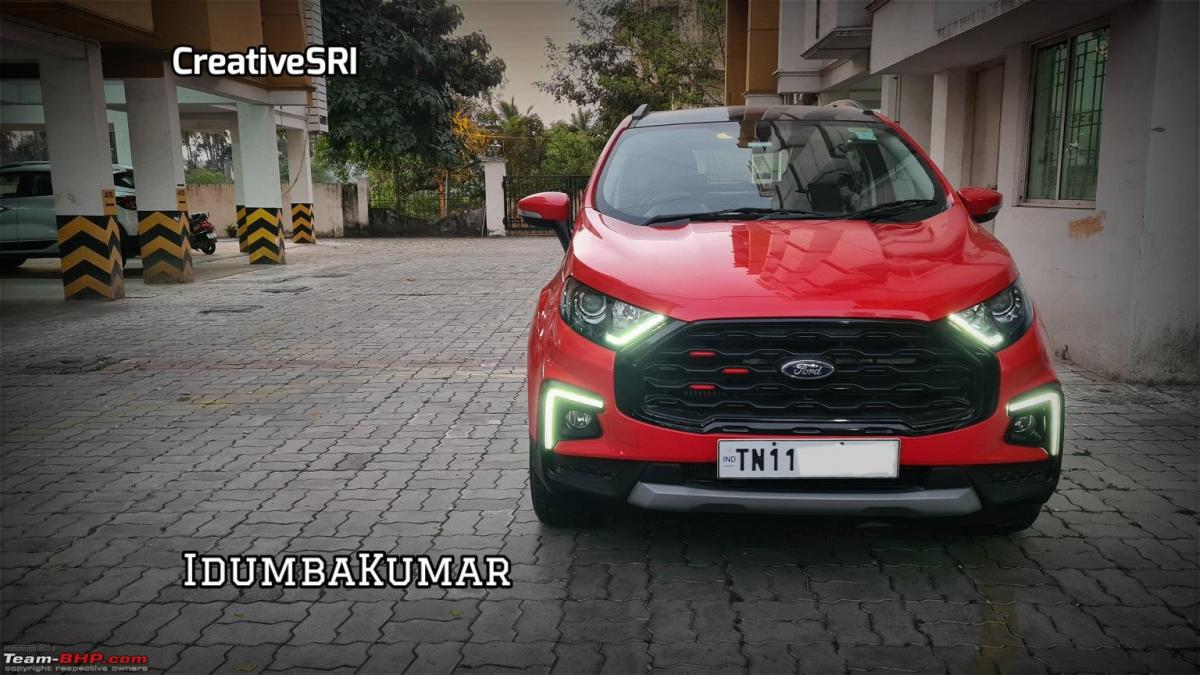


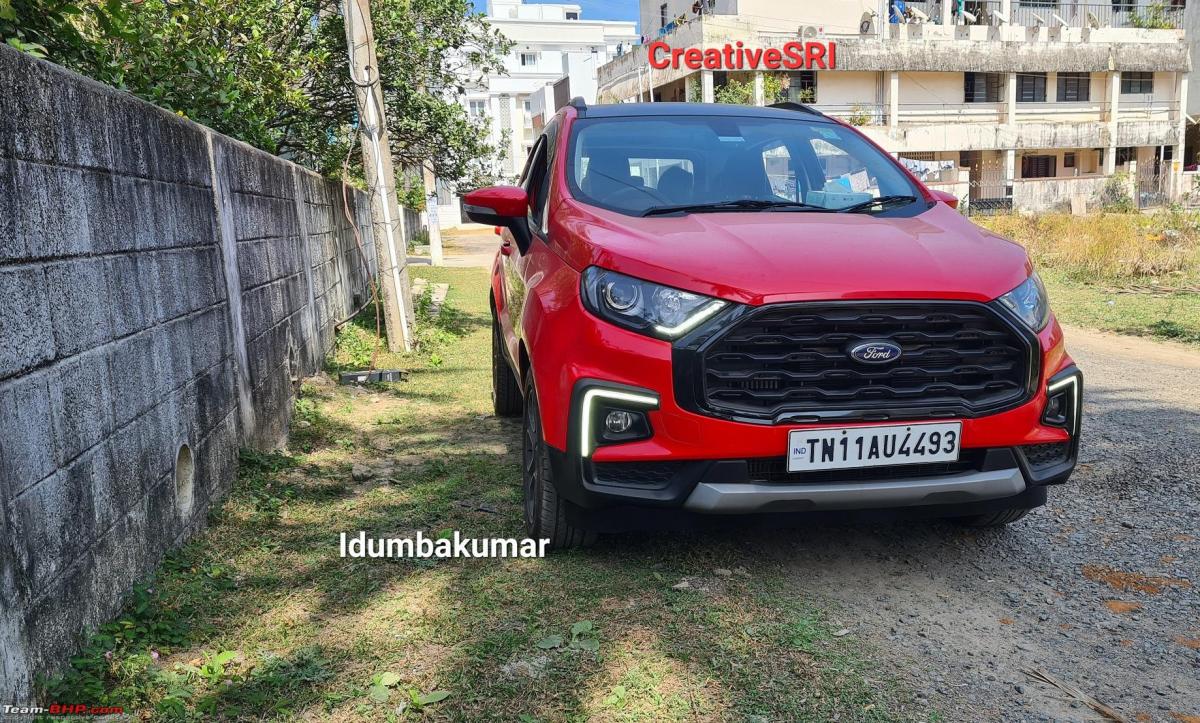

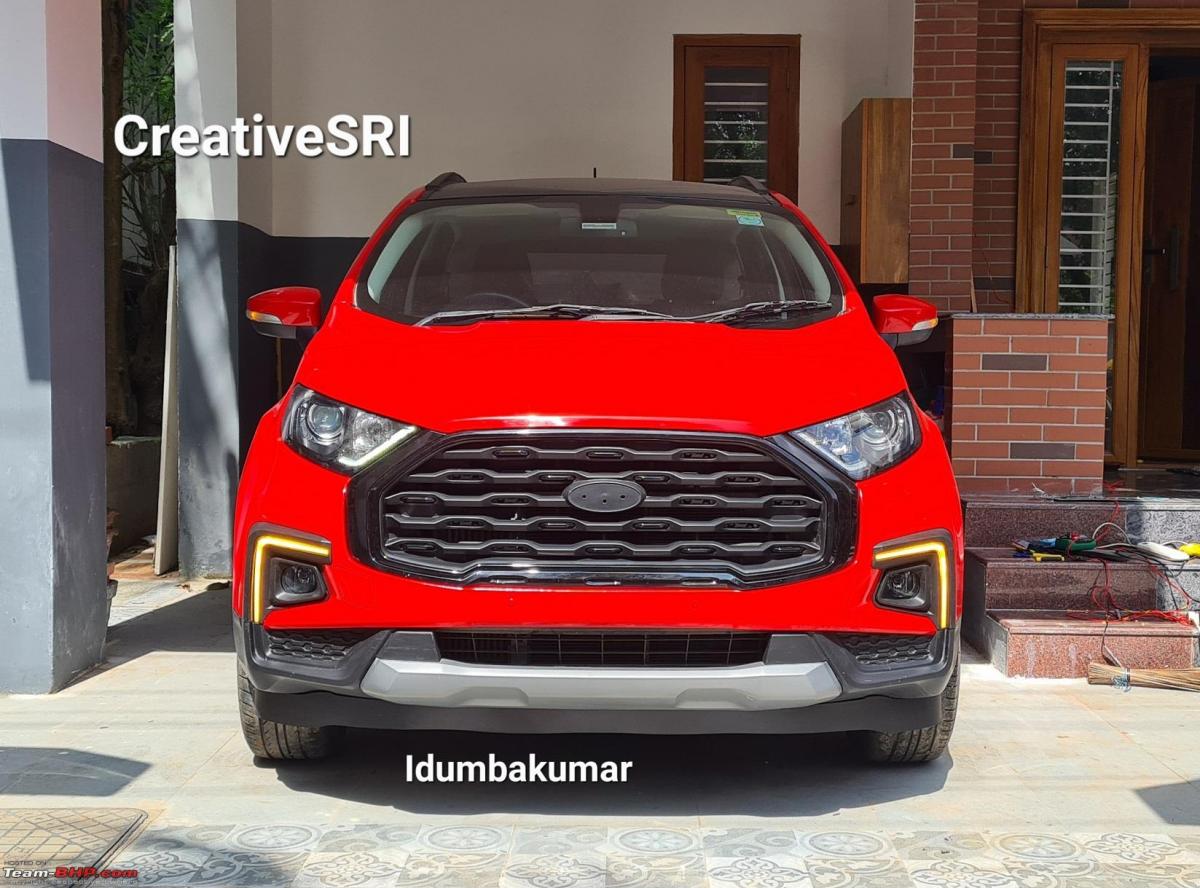

I smoked it for a proper "sports variant" look, without blocking the lit area:


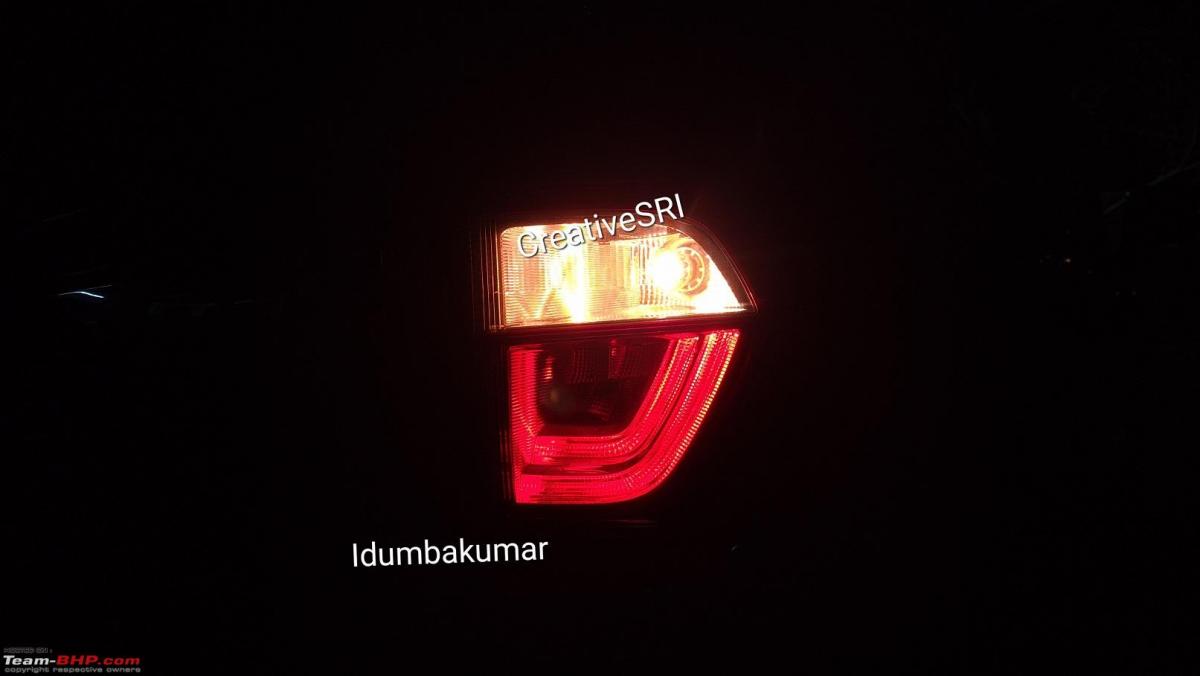
Please check the detailed video here.
I have put in a lot of effort into procuring and making them work. So please give proper credit whenever it's shared.
Check out BHPian comments for more insights and information.
News
Replaced my Skoda Rapid TDI with a Kia Sonet IMT: Initial impressions
My requirement was an proper automatic transmission (CVT, TC) or an IMT. AMT was not preferred.
BHPian hrman recently shared this with other enthusiasts.
I was in the market for a new car to replace my 11 yr run Skoda Rapid 1.6 TDI.
While I was happy with my Rapid in terms of FE, stability, space etc, the continuous clutch engagement and disengagement was taking a toll on my left leg in city driving. My to and fro to work in moderate to heavy traffic used to tire me a lot. The clutch had run for 70k kms in about 11 years had become hard, the hydraulic power steering started feeling heavy.
My requirement was an proper automatic transmission (CVT, TC) or an IMT. AMT was not preferred due to the many issues I read about on this forum about Maruti, Tata and Mahindra vehicles. DCT due to doubts on long term reliability was also not considered.
I had driven Nissan Magnite, Renault Kiger and Kia Sonet. Had asked Maruti for a test drive of the Brezza AT, but they took too much time to get the TD vehicle from some far off showroom and my timings did not match. Further the dealer informed me that there was a 4-5 month waiting period on the AT, and feature to feature was not comparable to other similar cars. I was looking forward to first time owning a Maruti car for the famed service experience and high resale, but well that couldn't happen this time.
My experience with driving a family Nissan Magnite was good. I loved the CVT, suspension setup and space. But a bit of concern that Nissan has only one car selling in India. Not sure of their future plans and doubts on their business continuity, which made me look at other options.
The Renault badge twin Kiger ticked all the boxes of the Magnite above, but was pricier. I lifted the bonnet and while placing it back, heard some rattles inside. The driver side left hand hand rest and placement of the seat belt bracket also didn’t seem ergonomic. Having rattles in a 7k driven test car was not encouraging so decided to drop it.
Nexon and XUV300 was not in consideration since they had AMT gearboxes and there were many service issues reported on this forum. While space and built are better in class and both are Indian brands, the reputation of their A.S.S. made me look elsewhere.
I had a pleasant experience with Kia. Called their JP Nagar showroom and they had an IMT test drive vehicle. Went there on time, liked the experience and the staff were very courteous and patient. I liked the IMT primarily because it gave the flexibility of using gears without the clutch. Enquired about delivery schedules and they promised delivery in 2-3 weeks. White and Black was readily available, but at that time I was looking for Red or Grey.
We visited the Yeshwantpur showroom and saw the cars in various colours face to face and finalised on white. I got delivery in 2.5 weeks post my booking. Since I had a white Rapid for 11 years I was looking at a different colour option but in comparison with other colours, we liked the white Sonet the best.
For selling my Rapid, enquired with the aggregators: Spinny, OLX Auto, Cars 24 and finalised on Spinny as they gave the highest quote. Even tried exchanging with KIA, but was offered a lower price and due to time constraints, didn't want to go scouting for individual buyers.
I have been driving the Sonet for 3 days, so here are my initial drive impressions:
Pros:
- Smooth gear shifts and light steering.
- Imposing SUVish stance
- Loads of features. ABS, EBD, 4 air bags, BA, VSM, HAC, ESC as safety features. Further Alloy wheels, integrated touch screen infotainment, automatic folding ORVMs, LED headlamps and tail lights, keyless entry, sunroof etc which were not in my 2012 Rapid.
- Android Auto and Bluetooth works great.
- Brakes are sharp and reassuring.
Can be better:
- Fuel economy is about 8.5-9 n city commute (should improve over time).
- 1st gear needs additional throttle and tends to lag. I was used to a more torquey 1.6L diesel (to get used to this).
- Body roll present at some points (CSUV behaviour).
- Suspension setup is stiff over bad roads. Would have loved it to be plusher. (past sedan experience).
All in all, I am happy with the Kia Sonet HTX IMT and looking forward to share more experiences on this forum.
Check out BHPian comments for more insights and information.
- Tags:
- Indian
- Kia Sonet
- Petrol
- IMT
- Compact SUV
News
My Tata Punch MT: Observations after clocking 10000 kms in 6 months
I haven't sat in the back seat yet, but my 60+ year-old parents joined me on a road trip to Lucknow and they were amazed by the comfort.
BHPian techmaharaj recently shared this with other enthusiasts.
A few years ago, I didn't feel the need for a car. That was mainly because I didn't have a place to park. However, I moved to a different part of Hyderabad which is quite far from the city. That meant that I now had to travel almost 60 km to visit the city. Not only did it take time, but riding on an Activa was way too tiring, plus the rains were a big deterrent. Further, cabs to anywhere in Hyderabad cost close to Rs 1000 on one side, which is way too expensive. That also hampered us as a family traveling around.
That’s when I thought it was time that I need a car. I did some thorough research, and test drives and eventually got the Tata Punch, my first car. It's the Adventure Rhythm with manual transmission. Our first car was a Maruti 800 DX, followed by the Tata Indigo that we drive for 1,50,000 kms. Both we let go as we moved cities and dad changed jobs. So the Punch came in after a long long gap!
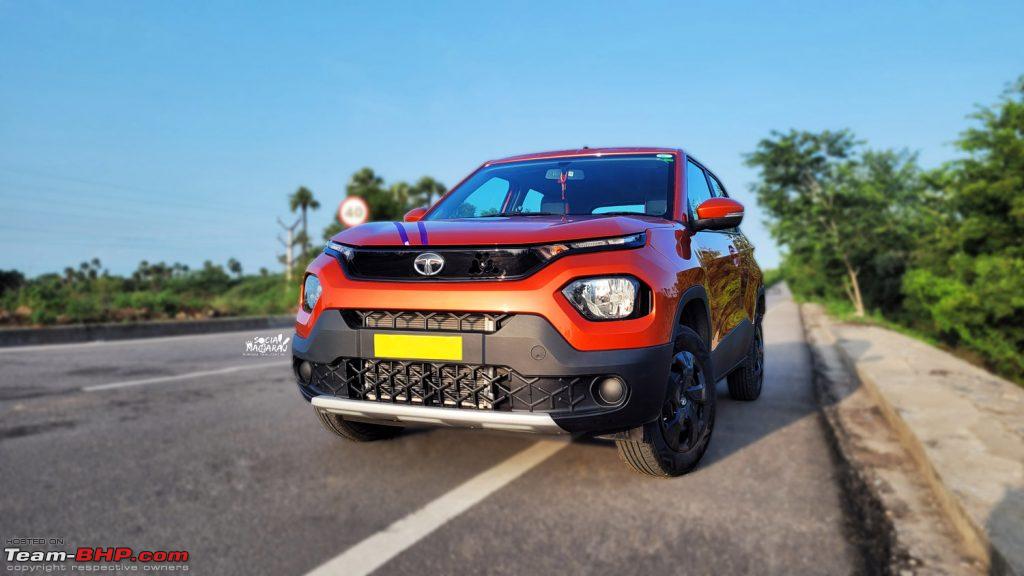
I also wrote two blog posts (9000 words) sharing my experience of buying a car in India.
Clocking 10,000 kms in 6 months:
Jan 26th is when the Punch completed 6 months and it was also when it crossed 10,000 kms! I knew that after I get the car, I'd be driving around. But never thought it would be this much. It has already undergone two free services, and there was nothing major in them. Both were free services and I didn't pay a penny.
In case you're wondering how and where I clocked 10,000, here are some details of my road trips:
- Hyderabad To Nagarjuna Sagar
- Hyderabad to Sri Sailam Dam
- Hyderabad to Pune/Panchgani
- Hyderabad to Bidar
- Hyderabad to Ramappa Temple (Warangal)
- Hyderabad to Medak
- Hyderabad to Lucknow - Team BHP Post
- Hyderabad to Bijapur, Aihole Pattadakal
All these road trips were to and fro, meaning I drove from Hyderabad and came back too. If you're interested, you can read more about each trip on my blog.
Though this is my first car, I've driven Hexa, Nexon, Tiago (Thanks to Tata Motors for inviting me to experience them), Brezza, Celerio, Sunny and Endeavour.
Having done 10,000 kms, I thought it was the best time to talk about the Punch, and things I like and dislike about it.
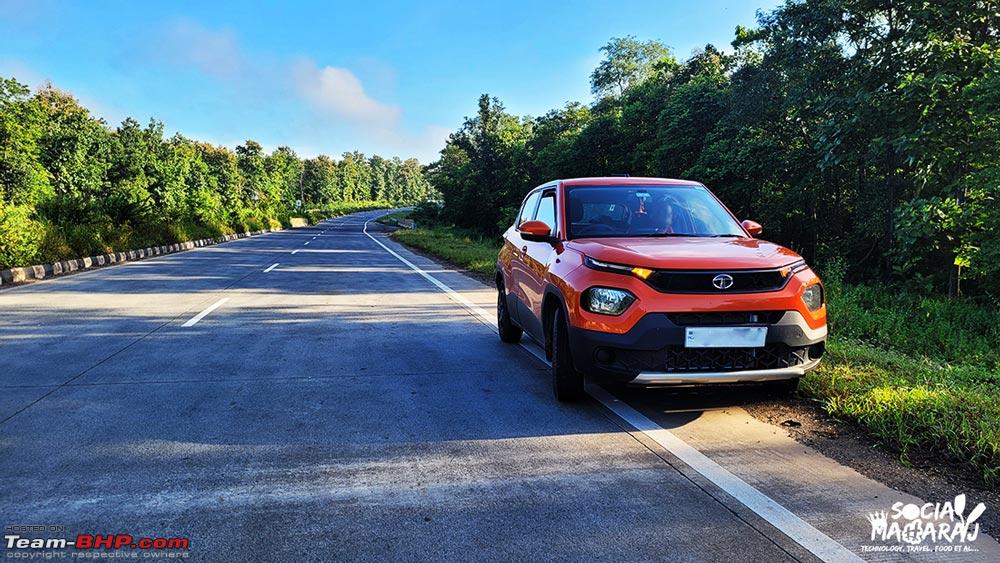
Things I like:
Smooth ride quality:
One of the best things about my Tata Punch is its amazing ride quality. The light steering at low speeds makes it effortless to maneuver in traffic and make quick turns. Plus, the small turning radius makes U-turns a breeze. At higher speeds, the steering becomes rock solid for better control and confidence. At 80-90 kmph, the ride is just fantastic.
The suspension is also perfectly tuned, smoothing out bumps and potholes with ease. Its higher ground clearance than other hatchbacks in the segment gives you peace of mind that you won't hit the bottom. The Punch handles off-roading and rough roads exceptionally well.
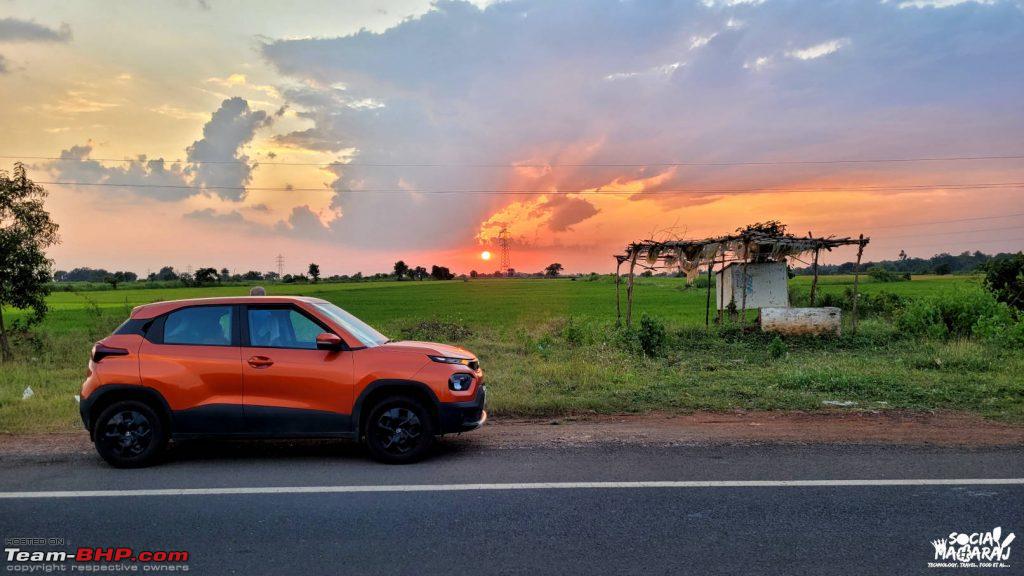
Comfortable seating:
The seats on my Tata Punch are incredibly comfortable. They're shaped for good back support and the under-thigh support is great for long drives without fatigue. The presence of a dead pedal makes it even more relaxing on highways.
I haven't sat in the back seat yet, but my 60+ year-old parents joined me on a road trip to Lucknow and they were amazed by the comfort. The car's height and 90-degree doors make it easy to get in and out, and the inclined seat angle made it comfortable for them. I give full marks for seating and comfort.
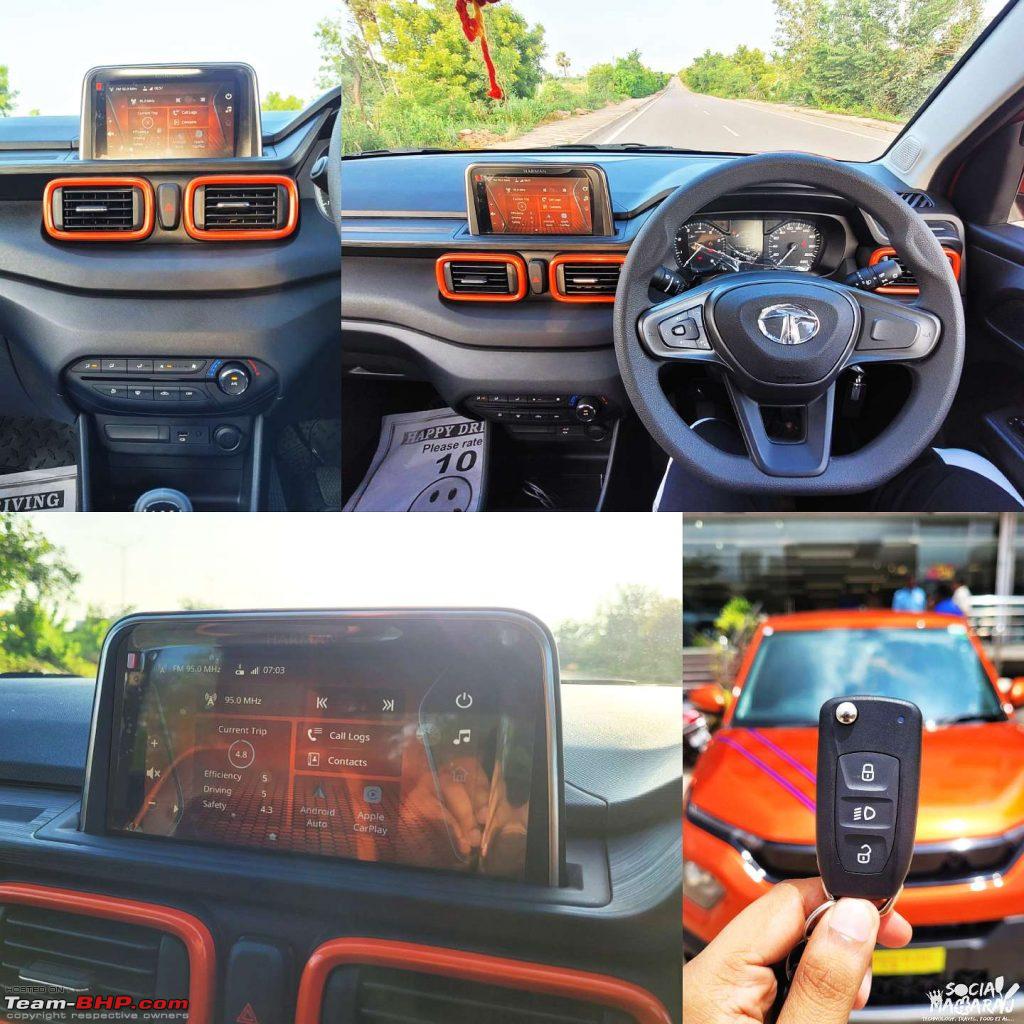
Good fuel efficiency:
Most of my driving is on the highways. I've seen an average mileage of 21-23 kmpl, based on the car's MID and my own calculations. I mostly drive in Eco mode barring when in cities and leaving highways. My long trips usually get me 22-23 kmpl (over 1000 km), which is very satisfying. My 120 km trip to Hyderabad (including 100 km of highway) gets me 24-25 kmpl. The highest I've gotten is 26.9 kmpl on ORR for a 60 km distance.
I'm not a speed fanatic and rarely go over 100. I like to cruise at 70-80 and don't like to accelerate hard, overtake, or cut lanes. That's just not my style.
Infotainment and AC:
The Harman sound system in the Tata Punch is fantastic, especially when using music apps like Spotify. The thump at volume 9 is impressive and the equalizer is great for fine-tuning the audio.
The call quality during calls is also great, with the other person not even realizing you're in the car. The air conditioner is also a highlight, being quick and powerful with a cooled cabin in just 5 minutes at full speed and low-temperature setting.
These were a few things I absolutely like about my Punch. However, there are a few things that surely can be improved or should have been better.
Things I dislike:
Lacks punch at higher speeds:
The Tata Punch has decent power at lower speeds but lacks acceleration at higher speeds and RPMs. Driving it in the city mode is fine, but when you reach speeds around 80-90 kmph in 5th gear, you'll notice a lack of power. Overtaking at this speed requires downshifting to 4th gear for extra power.
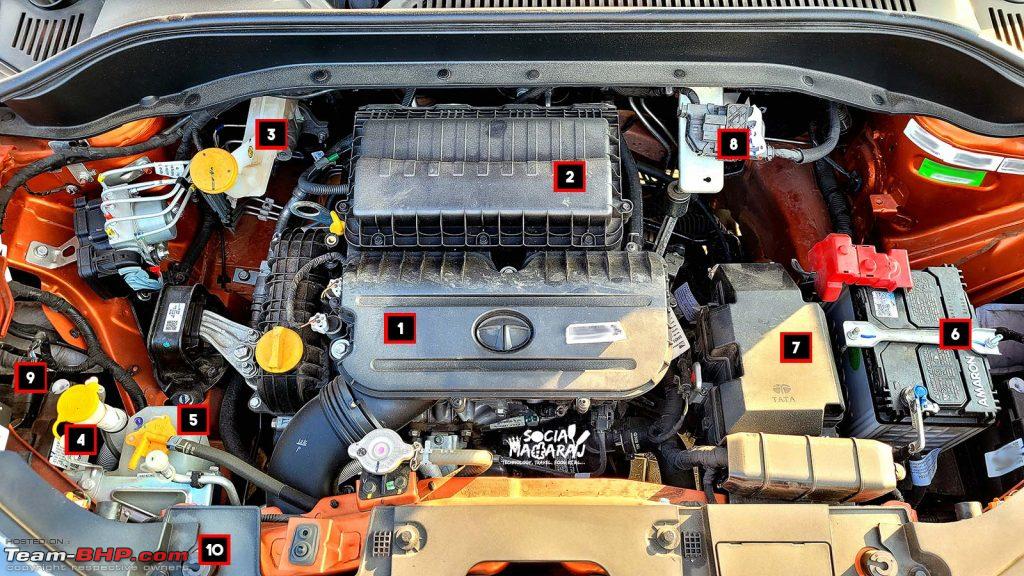
Adding a turbocharger may have improved performance, but it would have also increased the price. If you're a conservative driver who prioritizes comfort, the Punch may suit your needs. However, if you want a car with the race-like performance and quick overtaking abilities, the Punch may not be the right fit. Ultimately, the best way to know is to try it out yourself with a test drive.
Average braking:
The Punch provides a confident driving experience at high speeds due to its steering, suspension, and visibility, but its brakes are a letdown. Despite being a heavy vehicle, the brakes are soft and result in a longer stopping distance.
There have been instances where it took longer to come to a stop, causing a scare on the highways, especially in MP & UP where there are cow-meetings happening on the highways!
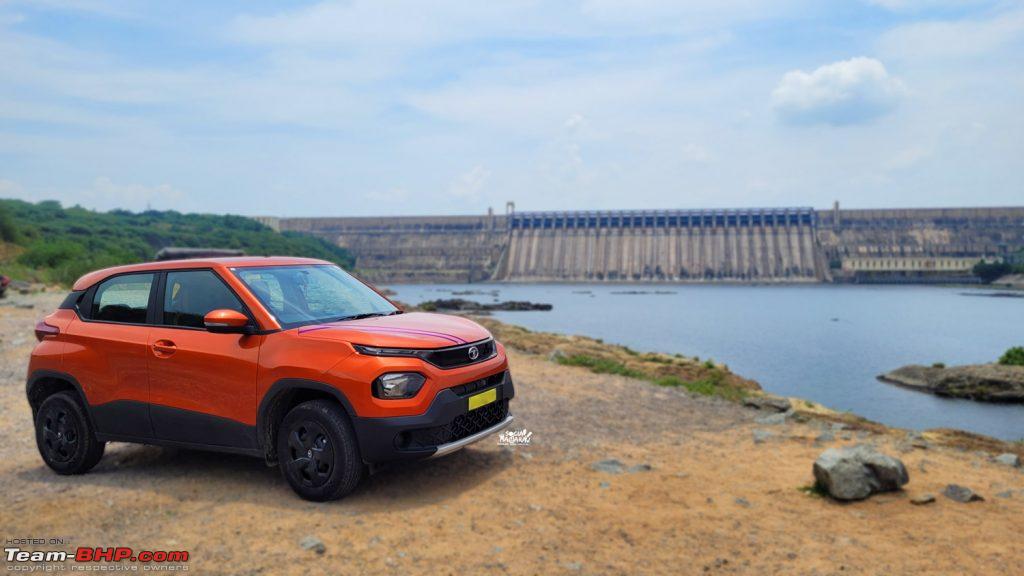
Noisy cabin:
Despite having some insulation under the hood, the Punch still allows engine noise to enter the cabin. When shifting gears to 4th or 5th, the revving engine can be heard inside. The engine's pickups also make some noise at times.
The noise level is reduced when the AC is turned on and music is playing, but it's still noticeable. Although the vibrations have been reduced, the cabin can still get quite noisy. You can try to not notice it, but it just gets your attention at times.
Poor finish/paint job:
Lastly, the poor fit and finish of the Tata Punch is a major drawback. The large panel gaps easily collect dust, leading to dirty door panels, boot, and bonnet. After long drives, it's noticeable how much dust has accumulated in these gaps.
The overall finish is subpar, with poorly cut and misaligned metal sheets and fiber components detracting from the look and feel of the car. Some areas have a white waxy substance that is difficult to remove.
The paint job is also below average. After parking the car in the sun, minor ghost lines were noticed on the bonnet.
Here's to another 10,000 kms!
In conclusion, after driving the Tata Punch for 10,000 km, I have found it to be a car that offers a great blend of comfort and performance. The Harman sound system is simply amazing and so is the call quality. The air conditioner is also quick and powerful, making it easy to have a chilled cabin in under 5 minutes. The seating is comfortable for long trips with good back and under-thigh support, also the dead pedal makes it a breeze.
However, the Punch does have some limitations when it comes to performance. At higher speeds and revs, the car lacks power and you can feel it when in 5th gear and higher speeds. The brakes also could have been better and the cabin can be noisy. The fit and finish of the car also leaves much to be desired, with huge panel gaps that accumulate dust and poor paint jobs.
In conclusion, if you're a conservative, comfort driver, the Tata Punch may be a great choice. However, if you're looking for a car that can perform like a race car and quickly overtake at higher speeds, I don't know if you'll like it.
Ultimately, it's best to do a test drive and experience it for yourself.
Check out BHPian comments for more insights and information.
- Tags:
- Indian
- Tata Punch
- Compact SUV
- Petrol
- Manual
News
Want a compact SUV in a 15 lakh budget: Confused between Nexon & Sonet
The car will be primarily used by me and my wife (and hopefully a future dog) most of the time.
BHPian krishnakumar recently shared this with other enthusiasts.
Hello BHPians!
I'm looking for a car at ~15L (max 16L) OTR for my first car ownership. While I'm new to car ownership, I've been driving cars for 10+ years now and have driven a variety of cars during this period.
Requirements:
The one-line requirement goes as this: "a car that'll get us around comfortably on highways and broken roads for long road trips and weekend mall crawls with occasional city usage".
The car will be primarily used by me and my wife (and hopefully a future dog) most of the time. However, we'll have our siblings and parents visit us 2-3 times a year. Hence, rear seat comfort, while not critical, is not to be ignored completely. I'm also expecting an annual mileage of 15,000km.
Some basic checklist features that I noted down based on above:
- High on safety.
- Great highway stability.
- High ground clearance - so ruling out sedans.
- Diesel engine - to keep the fuel costs low.
- Good practical boot size for carrying all the luggage around.
Few comfort features that support highway usage like - Cruise control, practical cabin for storage of phone, bottles etc.
The Shortlist:
The current cars under consideration are (in the order of priority):
Tata Nexon 1.5D XZ+(S)
Kia Sonet GTX Plus 1.5D
Car that came close:
Mahindra XUV3OO W8(O) - due to a lack of rear AC vent and a poor boot space, we're not very keen on this despite being a strong contender otherwise. This will be our only steed for a good time to come so we do not want to be in a position that makes us feel disappointed.
Used cars are a strict no from my wife.
The Assessment:
I did the test drive for both Nexon and Sonet, both manual. Up until this point, I was mostly clear on getting the Nexon, however, with the test drive things kind of changed.
Important: The Nexon TD vehicle was at 18k on ODO and the SA mentioned that it was due servicing at 15K which wasn't done. He also mentioned that there are issues with clutch and brake pads which are due replacements. There was also a "low" warning on the Nexon TPMS for the left front tyre.
Performance: In the performance department, the Sonet clearly felt better than the Nexon. It got up to speeds quickly and found it to have lesser turbo lag than Nexon. However, the Nexon SA mentioned that the lag is due to the clutch problem. I also found the Nexon engine to be very unrefined compared to the Sonet's. Again, the SA mentioned that Nexon is due for servicing and the gravelly engine is due to that. I'm planning to take another TD for the Nexon, but I suppose the Sonet would still win in terms of refinement and overall performance.
Verdict: Sonet > Nexon
Ride handling and dynamics: The Nexon was quite jiggly/bouncy at low speed rides but rounded off bumps quite smoothly. No jarring movements on bumps or potholes. I found the steering to be a little too heavy even at low speeds and found it to be strange. I have driven the Nexon BS4 for ~1000km and never found it this way. The SA said the steering is like this - did they change it in the facelift? The Sonet again won this department, although the ride quality on broken roads were jarring due to the stiff suspension. Steering felt light enough for city movements but with reassurance. Couldn't check if the steering weighs up nicely at higher speeds (since we were in city limits) but the SA confirmed that it does.
Verdict: Sonet > Nexon
Interiors and Ergonomics: The Nexon and Sonet, both, had comfortable seating for the driver and rear seats as well. My wife said that the Sonet had far better interiors, quite obviously. She was also concerned with the cleaning and maintenance of fabric seats on Nexon. The Sonet, since it has ventilated seats, scored far superior to Nexon. My family calls me a polar bear - I start sweating even at regular temperatures for most people and hence, the ventilated seats is a very usable feature for me. Overall practicality of the cabin was also better in the Sonet. For example, there is no place to put your phone in the Nexon (apart from your own pocket - is it for more safety?). But I found it weird that the only spot to keep the phone was that cover for the cup holders - which means we can't have both. Also, the phone wire would cross the gear knob and I found this to be an overall poor design. The small recess near the ports aren't big enough for most smartphone these days. These aspects are much better designed on the Sonet. Another quirk with Nexon was that the gear knob was far too much in the front, such that I'd have to reach for it - but I'm discounting this as I'm sure I'll get used to this in some time.
Verdict: Sonet > Nexon
Safety: Now here is where the tables turn. We don't know for sure how much the Sonet will score if crash tested, but if we were going with anything that's available as public information about the Korean twins, it is that the structural integrity is poor compared to the Nexon. While I know that the facelifted Nexon hasn't been crash tested, it can be reasonably assumed that the new car doesn't have too many body changes and hence would score well.
Verdict: Nexon > Sonet
The Confusion:
While as per my test drive the Sonet scores higher for both performance and handling, I'm not sure if this will hold up because on paper, the Nexon has better mechanical fundamentals. I understand that it could be because the Nexon TD vehicle was due service and requiring a couple of mechanical replacements. However, even if I'm just considering the Sonet individually, its performance and handling satisfied me to my needs.
Which leads me to the real confusion - the Sonet is a clear winner in terms of comfort, whereas the Nexon is a likely winner in terms of safety. In terms of safety equipment though I'm getting more from the Sonet (6 airbags) but I understand that airbags alone don't mean anything.
In terms of after sales support, I'm not sure which would fare better. On one hand, I have Kia which is likely to push me stuff that I don't need and on the other hand, there is TASS which is likely to not do stuff that I push them to do.
Both the dealers agreed to let me do the PDI along with their staff before the VIN registration and final payment, although both of them requested for the down payment to be done at the time of allotment (which I found reasonable - thoughts from BHPians?).
I'm fully confused and my constant bickering about this has made my wife lose her head. She's saying pick anything and be done with it.
My brethren, kindly help me!
Here's what BHPian zandot had to say on the matter:
As someone who has purchased a Kia (seltos) and a Tata (nexon ev) within the past year, I would urge you to consider the Kia as Tata after sales is a nightmare.
Kia also has their shortfalls in terms of their sales advisors riding high on their brands success - not give a damn attitude as their vehicles will sell regardless, their brand new service centers and after sales are much stronger than Tata.
Also imho Kia is a superior product in terms of the build quality.
Here's what BHPian abhishek46 had to say on the matter:
Since the Nexon TD vehicle that you tested was a faulty one, I would strongly recommend that you take another Test Drive, at some other dealership.
You can consider the Venue as well. Its the same as the Sonet, however Hyundai After Sales is arguably better than Kia.
Also, since you are already nearing 16lakh budget, why not consider the Mid variants of Creta/Seltos diesels?
Here's what BHPian Mafia had to say on the matter:
+1 to what abhishek46 said.
Find a dealer who has a newer vehicle. Test ride in a couple of showrooms if required before you make up your mind.
Tata's have a bad set of sales reps in my experience.
The after-sales service of both brands is struggling to keep up with the surging sales. Just today, I was reading about Tata's struggles. Kia is not faring much better.
Not an easy choice to make if you are thinking a lot without test rides. See if you can meet owners in your friends or relatives circle. Rent them if available in Zoom cars or some such. I chat up random strangers if there is a chance to get a better perspective in traffic signals or parking lots.
Please do let us know of your choice when you do make it.
Apologies for not helping.
Here's what BHPian Kick'OKicks had to say on the matter:
For Rs. 15 lakh budget after festival discounts and other usual exchange bonus, one can get Nissan Kicks Turbo CVT or Turbo MT. If you don't bother about Turbo you may get 1.5 NA XV or XV Premium substantially at lower price points like Rs. 11 lakh range. Kicks is a bigger SUV in the segment, dimension wise though interiors may give you different perspective, especially the rear seat spacing.
Nissan Kicks doesn't have the sunroof and flashy interiors but I feel 1.5 XV P range has better dual tone interiors than its top end variant. The Mercedes engine fitted in the Turbo editions gives you the best ride quality. The I-SPVT intelligent suspension ensures minimum or no body roll, its safety features like Hill Start Assist, Traction Control, Electronic stability program are very important safety features generally available only in the 20-22 lakhs variants from other car makers.
My Kicks Turbo CVT gives me maximum of 19-21 kmpl on highway if you keep the RPM below 2000 and maintain speed between 80-90. City driving gives me around 13 KMPL maximum. Driving the Kicks CVT in the city traffic gives absolute peace of mind by leaving your legs from clutch workings and hands from gear shifting.
My best wishes for you in choosing your best vehicle!!
Here's what BHPian ynike99 had to say on the matter:
Out of the two, I would consider the Sonet. When I made my purchase of Seltos, I had considered all the 4-4.4m cars(Diesel) for the same reason as yours, that I love low end torque. The engine/gearbox combo of Kia Diesel in both Manual and Auto is something to be experienced. Nexon was in my short list right till the top 3 cars(Others were Seltos and Creta Old gen). But somehow after multiple TDs, I could find some fault with all the TD cars. Some niggle/Ergonomic issues etc used to crop up every time, whereas Creta/Kia were pretty consistent throughout.
Regarding Kia on service front, its really good till date. Service is timely and proper, Parts are stocked well and its generally a good experience at service center.
Check out BHPian comments for more insights and information.
- Tags:
- Indian
- Compact SUV
- Tata Nexon
- Kia Sonet
Pages



